Karl Shuker's Blog, page 36
August 10, 2015
THE HYDRA OF LERNA – GETTING AHEAD (OR SEVERAL!) IN FICTION, FAKERY, AND FACT
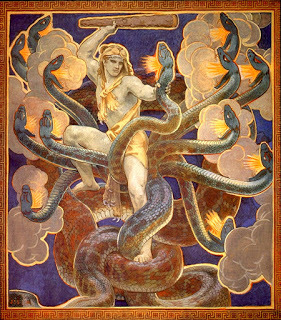 Exquisite depiction of Heracles battling the hydra by John Singer Sargent, 1921 (public domain)
Exquisite depiction of Heracles battling the hydra by John Singer Sargent, 1921 (public domain)Among the most unusual, and deadly, dragons, of classical mythology was the Lernaean hydra - whose slaying constituted one of the twelve great labours of the Greek hero Heracles (Hercules in Roman mythology).
Although this monster is usually depicted as wingless and only two-legged, thereby resembling the lindorm morphological category of dragon, it was more than ably compensated by virtue of its numerous heads (generally given as nine, but sometimes only seven, or as many as thirteen), each borne upon a separate neck. And each time that a head was cut off, two new ones grew in its stead, until Heracles successfully countered this by burning each neck as soon as its head was lopped off.
Yet despite this brave act putting an end to the hydra as a living entity, its name and fame have lived on, passing down throughout history, remaining vibrant and indescribably versatile even today - as will now be revealed.
 The hydra as portrayed in Conrad Gesner's famous bestiary Historiae Animalium(1558) (public domain)
The hydra as portrayed in Conrad Gesner's famous bestiary Historiae Animalium(1558) (public domain)HOW HERACLES DISPATCHED THIS MANY-HEADED DRAGON OF CLASSICAL MYTHOLOGY
The chimaera - a lion-headed monstrosity with a goat's head sprouting from its back, and a living serpent for a tail. The dragon Ladon - ferocious protector of the Hesperides' garden of the golden apples. Orthos, a fearful hound with two heads - and his even more hideous brother, the three-headed hell-hound, Cerberus. These were just a few of the gruesome monsters spawned in ancient Greece by the union of a terrifying hundred-headed giant called Typhon and his equally loathsome bride, the serpent-bodied Echidna - but none was more horrifying than the most terrible member of their vile brood, for that was the hydra.
Little wonder, then, that even the fearless hero Heracles was somewhat apprehensive as he stood outside the vast dank cave at Lerna that harboured this monstrous creature. As the second of his twelve great labours, he had been sent to this tormented district of Argolis, in southern Greece, by the cowardly king Eurystheus, who had commanded him to liberate Lerna by slaying the hydra - which was wilfully slaughtering its populace, and blighting with virulent vapour its countryside, transforming it into a gloomy wilderness of marshland.
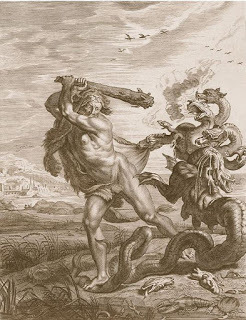 French engraver Bernard Picart's dramatic depiction of Heracles clubbing the hydra (public domain)
French engraver Bernard Picart's dramatic depiction of Heracles clubbing the hydra (public domain)Assisted by his nephew Iolaus, who had faithfully accompanied him on this dangerous quest, Heracles lit a series of torches that they had fashioned from bundles of grass, and fired them into the hydra's grim lair in order to expel its foul occupant. Great clouds of evil-smelling smoke billowed out of the cave-mouth, and at the very heart of this choking mass of fumes something writhed, and roared. The two men backed away, coughing and wiping the acrid vapour from their streaming eyes - and when they looked back, they beheld a sight so dreadful that even the fiery blood of Heracles ran cold in his veins.
The smoke had dispelled, exposing an immense bloated mass of pulsating flesh, obscenely corpulent and of a sickening pallid hue. Superficially, it invited comparison with a grotesque octopus or squid, for above this obese, sac-like body thrashed a flailing mass of lengthy tentacle-like appendages - but that was where any such resemblance abruptly ended. For as Heracles and Iolaus could see only too clearly, these 'tentacles' were, in fact, long, powerful necks - and each of these necks, nine in total number, terminated in an evil horned head, the head of a dragon. This, then, was Heracles's grisly adversary - the Lernaean hydra.
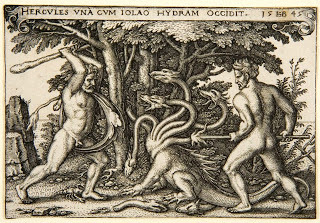 Heracles and Iolaus dispatching the hydra with club and fire, depicted in 1545 by German engraver-painter Hans Sebald Beham (1500-1550) (public domain)
Heracles and Iolaus dispatching the hydra with club and fire, depicted in 1545 by German engraver-painter Hans Sebald Beham (1500-1550) (public domain)When its heads spied him, they emitted a deafening sibilation of hissing fury that whistled through his ears like a thousand shrieking ghosts, and each lunged forward, intent upon seizing this puny, vainglorious human in its bone-crunching jaws. Undaunted, Heracles raised his mighty club, and swung it down with terrible force, crushing into a shapeless mass the skull of the nearest of the nine - but to his horror, the head did not die. Instead, its flattened cranium promptly expanded, enlarged, and split into two - and each of the two halves immediately transformed into a new head. From the single original version, shattered by Heracles's club, two brand-new heads had instantly regenerated! Moreover, this deadly duplication occurred every time that he succeeded in destroying one of its heads.
Soon, the hydra would possess such a quantity of heads that it would certainly quash even the unrivalled monster-annihilating prowess of Greece's most exalted hero - unless he could devise a method of preventing them from replicating. Glancing at the smouldering sheaves of grass that he had used to drive out the beast from its cavernous retreat, however, Heracles suddenly saw an answer to his dilemma, and he quickly set Iolaus to work, preparing a new set of flaming torches.
 Heracles clubbing the ferocious hydra, depicted by the Baroque-Era French engraver Gilles Rousselet (1610-1686) (public domain)
Heracles clubbing the ferocious hydra, depicted by the Baroque-Era French engraver Gilles Rousselet (1610-1686) (public domain)Yet another of the hydra's heads swung down, jaws fully agape in a bid to grasp Heracles with its venomous fangs, and once again he crushed its skull with a single crunching blow of his bloodied club - but before it could begin to bifurcate into two new heads, Iolaus handed him a fiery brand, which he thrust into the gory pulp of the original smashed skull. The flames incinerated its flesh, which meant that it could no longer replicate - Heracles had discovered the secret of destroying the hydra!
From then on, the battle became increasingly one-sided - each head that attacked was swiftly destroyed with physical force and burning flame, until at last only a single head remained. This one, however, was immortal, immune to the scorching rapture of fire - but not to the merciless, decapitating thrust that it received from Heracles's razor-sharp sword.
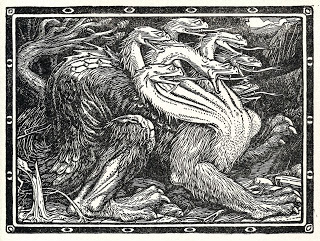 An uncommonly hirsute seven-headed dragon, as portrayed in this early 20th Century illustration by John D. Batten (public domain)
An uncommonly hirsute seven-headed dragon, as portrayed in this early 20th Century illustration by John D. Batten (public domain)The most terrible polycephalic dragon that the world had ever seen was no more, and never would be again - not even Typhon and Echidna could have spawned its hideous likeness a second time.
WAS THE MYTHICAL HYDRA INSPIRED BY MAINSTREAM CEPHALOPODS?
It is interesting to note that certain depictions of the Lernaean hydra on ancient Greek pottery were quite evidently inspired not by a reptilian dragon, but rather by either an octopus or a squid.
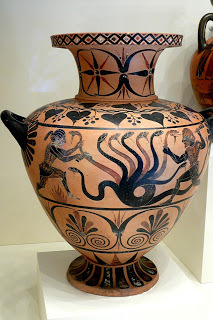 Heracles and the Hydra Water Jar (Etruscan, c. 525 BC) (© Getty Villa - Collection /Wikipedia)
Heracles and the Hydra Water Jar (Etruscan, c. 525 BC) (© Getty Villa - Collection /Wikipedia)Both of these multi-tentacled cephalopod molluscs are common in the seas off Greece and its islands, and it is easy to understand how, after seeing a captured specimen on land flailing its tentacles about its large bulbous body, the legend of a monster with numerous necks could have arisen.
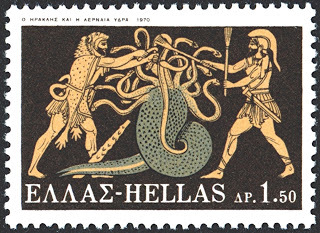 Depiction of Heracles battling an octopus-like hydra on ancient Greek pottery, as reproduced upon a Greek postage stamp from 1970 in my collection (© Greek postal service)
Depiction of Heracles battling an octopus-like hydra on ancient Greek pottery, as reproduced upon a Greek postage stamp from 1970 in my collection (© Greek postal service)In modern-day zoology, the hydra lives on at least in name if not in nature, courtesy of a group of small freshwater cnidarian polyps known as hydras. These can readily yield multi-headed forms if injury, or deliberate intent via laboratory experiments, divides their original single heads into two or more sections, each section duly regenerating into a complete head but remaining attached to the single body. Also, several buds can develop asexually from a single body, each with its own head; usually they then break off to become separate entities, but sometimes they remain attached to their progenitor polyp.
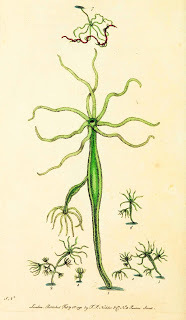 Vintage illustration from The Naturalist's Miscellany, vol. 1, 1789, depicting the green hydra Hydra viridis (public domain)
Vintage illustration from The Naturalist's Miscellany, vol. 1, 1789, depicting the green hydra Hydra viridis (public domain)LINNAEUS AND THE HOAXED HYDRA OF PRAGUE
Truly marvellous in its own deceiving manner was the hoaxed hydra that was removed from a church in Prague in 1648 and subsequently owned by Johann Anderson, the Burgomaster of Hamburg. So spectacular was this preserved wonder that Anderson even rejected an offer of 30,000 thalers for it from Frederick IV, king of Denmark. In basic form, the hydra resembled a standard lindorm, sporting a long tail and sturdy scaled body but only two limbs and no wings. Instead of just a single neck and head, however, it boasted no less than seven of each, with all of the necks emerging from a common base.
Yet despite the hydra's extraordinary appearance, its perceived monetary value eventually decreased, until by 1735 negotiations had begun for its sale at a mere 2000 thalers. Before these could be completed, however, eminent naturalist Carl Linné (who subsequently Latinised his name to Linnaeus) examined this celebrated specimen, and exposed it as a fraud. The heads, jaws, and feet were those of weasels, and a series of snake skins had been pasted all over its body.
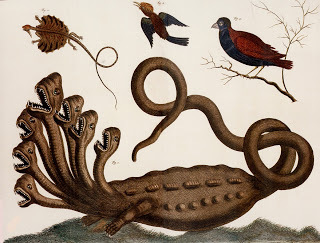 Depiction of the hoaxed hydra of Hamburg in Albertus Seba's Cabinet of Natural Curiosities (Vol. 1), 1734 (public domain)
Depiction of the hoaxed hydra of Hamburg in Albertus Seba's Cabinet of Natural Curiosities (Vol. 1), 1734 (public domain)Linnaeus speculated, however, that this exhibit had probably been created not by wily vendors to sell as a supposedly genuine hydra to some unwary buyer for an eye-watering sum of money, but rather by monks as a representation of the seven-headed dragon of the Apocalypse with which to chastise and terrify disbelievers. Yet whatever the reason, the result was outstanding, but even so, once this hoaxed hydra's true nature had been revealed by Linnaeus, the deal for its sale fell through, and shortly afterwards the hydra itself vanished – never to be seen again.
Incidentally, the seven-headed dragon of the Apocalypse, bearing ten horns and seven crowns, was the guise assumed by the devil, who fought with his rebel angels against the valiant St Michael and the mighty hosts of Heaven, as narrated in the Bible's Book of The Revelation of St John the Divine. Ultimately, St Michael cast the dragon out, hurling him down to earth with his mutinous acolytes. It is illustrated in various of the tapestries constituting the medieval French Apocalypse Tapestry (Tapisserie de l'Apocalypse), which depicts the Apocalypse from the Revelation of St John. The oldest surviving French tapestry, it was commissioned by Louis I, the Duke of Anjou, and was produced between 1377 and 1382.
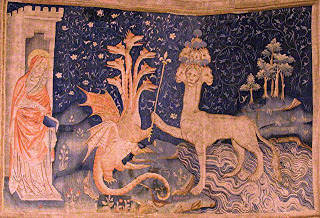 'The Beast From the Sea' ('La Bête de la Mer'), one of a series of tapestries constituting the medieval Apocalypse Tapestry (Tapisserie de l'Apocalypse); this one depicts the Dragon of the Apocalypse handing its sceptre of authority to the leopard-bodied Beast from the Sea, also seven-headed but with lion heads, not dragon heads (public domain)
'The Beast From the Sea' ('La Bête de la Mer'), one of a series of tapestries constituting the medieval Apocalypse Tapestry (Tapisserie de l'Apocalypse); this one depicts the Dragon of the Apocalypse handing its sceptre of authority to the leopard-bodied Beast from the Sea, also seven-headed but with lion heads, not dragon heads (public domain)THE HYDRA IN DREAMS, THE HEAVENS, HERALDRY, AND ART
Different types of dragon mean different things in dreams. A classical dragon with wings, for instance, can epitomise a transition, an ascent from a lower to a higher level of maturity. A many-headed hydra, conversely, signifies that the dreamer is plagued by a recurrent problem, one that he has tried to deal with several times but always unsuccessfully, so it is still appearing in his life, awaiting a satisfactory, conclusive resolution.
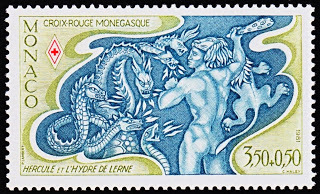 Heracles attacking and being attacked by the hydra as portrayed in this postage stamp issued by Monaco in 1981, from my collection (© Monaco postal services)
Heracles attacking and being attacked by the hydra as portrayed in this postage stamp issued by Monaco in 1981, from my collection (© Monaco postal services)Heracles's most formidable foe is represented in the night sky by a constellation, but no ordinary, insignificant one – nothing less than Hydra, the largest constellation of all, and one of the 48 constellations first recognised by Ptolemy. Yet despite its name, the distribution of its stars across the sky is such that Hydra the constellation bears much more of a resemblance in shape to a writhing single-headed serpent than to the polycephalic monster battled by Heracles. This in turn can cause a degree of confusion with another constellation, Hydrus, which is represented as a water snake. Moreover, Hydra itself is adapted from an ancient Babylonian serpent constellation.
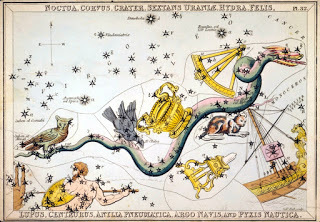 Hydra constellation, in Urania's Mirror (public domain)
Hydra constellation, in Urania's Mirror (public domain)Heracles himself is also represented in the night sky by a constellation – Hercules (his Roman name). Fifth largest in the night sky and another of Ptolemy's 48 originals, this constellation, interestingly, is believed by some researchers to have originally been united by ancient Babylonian sky-watchers with Draco, yielding a serpent-bodied human.
The dragon is a very popular symbol in heraldry, and appears in many different forms. One of these is the hydra, but no ordinary one. As if this monstrous creature were not deadly enough already, a seven-headed hydra sporting a pair of wings appears in the crest of various French families, including Barret, Crespine, and Lownes.
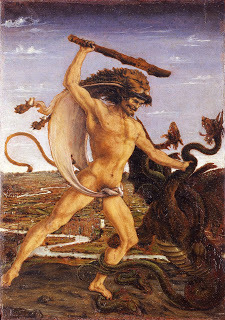 The hydra being clubbed by Heracles in a painting by Antonio del Pollaiolo (public domain)
The hydra being clubbed by Heracles in a painting by Antonio del Pollaiolo (public domain)Popular subjects for Renaissance artwork were the twelve labours of Heracles, including the slaying of the Lernaean hydra. Having said that, it was a decidedly scrawny, unimpressive specimen that was clubbed senseless by the hero in the painting by Italian artist and sculptor Antonio del Pollaiolo (1432-1498). Equally unimposing (albeit feather-winged) was the individual confronted by Heracles in an oil painting on wood from 1555-56 by Italian painter Marco Marchetti of Faenza.
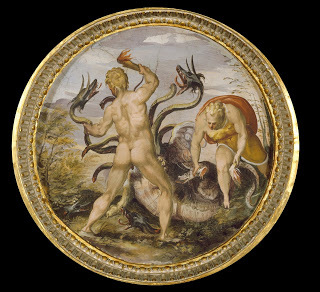 Hydra oil painting by Marco Marchetti of Faenza (public domain)
Hydra oil painting by Marco Marchetti of Faenza (public domain)Fortunately, however, more formidable depictions of this many-headed lindorm also exist, such as the robust portrayal by Spanish painter Francisco de Zurbarán (1598-1664), as well as various post-Renaissance examples, like the vibrant engraving by Bernard Picart (1673-1733), and a truly exquisite portrayal by American artist John Singer Sargent (1856-1925), which opens this present ShukerNature blog article.
 Francisco de Zurbarán's dark, nightmarish portrayal of the battle between the hydra and Heracles, painted in 1654 (public domain)
Francisco de Zurbarán's dark, nightmarish portrayal of the battle between the hydra and Heracles, painted in 1654 (public domain)Nor could we – or should we – forget the huge, spectacular sculpture of Heracles confronting a truly terrifying hydra created by Danish Symbolist-allied sculptor Rudolph Tegner (1873-1950), installed in Elsinore, Denmark.
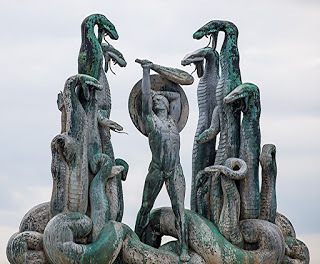 Rudolph Tegner's spectacular sculpture at Elsinore, Denmark (© Rudolph Tegner/Flickr)
Rudolph Tegner's spectacular sculpture at Elsinore, Denmark (© Rudolph Tegner/Flickr)Perhaps the strangest hydra portrait, however, is its depiction as a giant multi-limbed lobster-bodied monstrosity battling Heracles and Iolaus in an engraving dating from 1565.
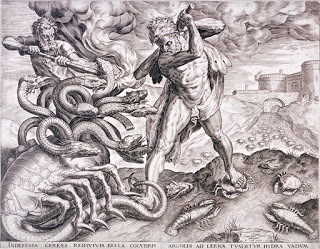 The hydra portrayed as a weird composite of many-headed dragon and multi-limbed, carapace-bodied crustacean (public domain)
The hydra portrayed as a weird composite of many-headed dragon and multi-limbed, carapace-bodied crustacean (public domain)THE HYDRA IN THE MOVIES AND IN LITERATURE
The hydra has featured in a number of films, and also in various works of fiction.
In the classic stop-motion fantasy film 'Jason and the Argonauts' (1963), featuring the astonishing creations of Ray Harryhausen, the Golden Fleece sought by Jason and his men is guarded by the Colchis dragon. Although this is usually depicted as a winged classical dragon, for maximum visual appeal Harryhausen represented it in this film as a multi-headed hydra-like version instead. It kills one of Jason's men, the treacherous Acastus, before being slain by Jason himself, who is then able to steal the Golden Fleece, and later returns with it in triumph to Thessaly.
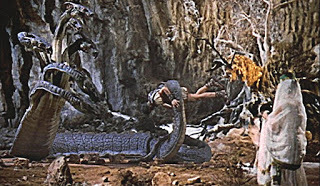 Ray Harryhausen's spectacular Colchis hydra in the 1963 British Columbia Pictures fantasy movie 'Jason and the Argonauts' (© Columbia Pictures)
Ray Harryhausen's spectacular Colchis hydra in the 1963 British Columbia Pictures fantasy movie 'Jason and the Argonauts' (© Columbia Pictures)In 1997, the Disney animated feature film 'Hercules' was released, and, as befitting a movie based (albeit loosely) upon tales from Greek mythology, it included an epic battle between the young demi-god hero and the Lernaean hydra. This multi-headed dragon has been summoned by Hades to destroy Hercules, but when he successfully kills it by causing a landslide, our hero finds himself elevated to celebrity status among the general public.
CineTel Films released a made-for-cable-television movie entitled 'Hydra' in 2009, subsequently making it available internationally on DVD. A slick blend of thriller, horror, action, and mythology, it tells the tale of how the legendary Lernaean hydra is reawakened from centuries of dormancy by a major seaquake near its volcanic Mediterranean island domain. The bloodthirsty many-headed monster, no doubt hungry after its prolonged fasting, proceeds to chomp up everyone who sets foot on its island, including a party of man-hunters, some of their ex-convict targets (one of whom is played by Hollywood and television actor George Stults), and even one of the film's two leading protagonists, a female archaeologist. The special effects breathing life into the hydra are as impressive as its rapacity for its human prey is unrelenting.
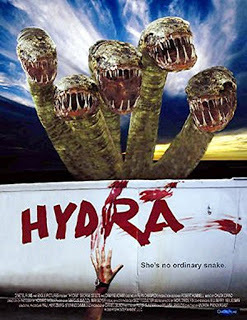 Poster from the 2009 CineTel Films movie 'Hydra' (© CineTel Films)
Poster from the 2009 CineTel Films movie 'Hydra' (© CineTel Films)William Beckford's initially anonymous Gothic novel Vathek, published in 1786 and telling the fall from power into eternal damnation of the Caliph Vathek of the Abassides, features a winged hydra called Ouranabad.
 A Ballantine Books edition of Vathek(© Ballantine Books)
A Ballantine Books edition of Vathek(© Ballantine Books)Dragons of a traditional, ferocious nature appear in various volumes of the long-running series of children's fantasy novels entitled The Spiderwick Chronicles (2003-2004) and Beyond the Spiderwick Chronicles (2007-2009) by Tony DiTerlizzi and Holly Black. These include serpent dragons like the venomous worms reared by the evil ogre Mulgarath, and a huge many-headed hydra with gills known as the Wyrm King.
An acid-spitting hydra, whose life-force is linked to the ever-increasing appearance of Monster Donut shops, appears in Rick Riordan's teenagers' fantasy-adventure novel, The Sea of Monsters, the second in his bestselling Percy Jackson series, but it is slain by a cannon from a battleship.
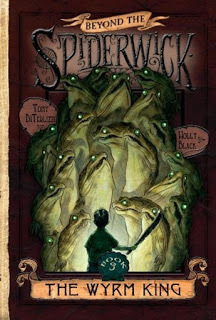 The Wyrm King
– Book #3 in the Beyond the Spiderwick Chronicles series, published in 2009 (©Tony DiTerlizzi and Holly Black/Simon & Schuster)
The Wyrm King
– Book #3 in the Beyond the Spiderwick Chronicles series, published in 2009 (©Tony DiTerlizzi and Holly Black/Simon & Schuster)Inventorum Natura: The Expedition Journal of Pliny the Elder (1979) is a spectacular tome compiled and exquisitely illustrated by fantasy writer-artist Una Woodruff. The premise behind this very skilfully-prepared volume is that it is a painstaking reconstruction of a supposedly long-lost work written in Latin by real-life Roman author-naturalist Pliny the Elder (23-79 AD), describing the astonishing fauna and flora that he allegedly observed during a purported three-year expedition to distant lands, an incomplete version of which Woodruff happened to rediscover. It includes several types of dragon – the pyrallis, basilisk, sea dragons, dragon-fishes, amphisbaena, Eastern dragons, Western dragons, and a British hydra.
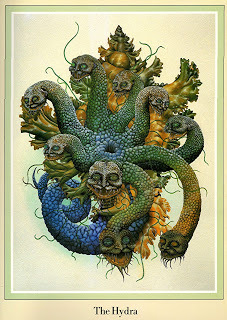 Britain's very own hideous hydra, from Inventorum Natura (© Una Woodruff)
Britain's very own hideous hydra, from Inventorum Natura (© Una Woodruff)A UBIQUITY OF HYDRAS
Nor is this the extent of the hydra's popularity – indeed, even today it is virtually ubiquitous in the frequency and diversity of namesakes and commemorations. These include (but are by no means limited to): Hydra, the outermost known moon of the dwarf planet Pluto, discovered in June 2005; Hydra, an American professional wrestler; Hydra, one of the the Saronic Islands of Greece in the Aegean Sea, which I visited back in 1977 (though technically this is named after the water springs there rather than the monster); Hydra, a fictional secret terrorist organisation in the Marvel comics, and also a villain in Lee Falk's comic strip 'The Phantom'; Hydra, an American southern rock band; the Hydra Trophy, which is awarded to the winner of the roller derby WFTDA Championships; Hydra, a chess computer; 'HMS Hydra', the name of several different Royal Navy vessels; Hydra, an early computer software operating system, created in 1971 at Carnegie-Mellon University; Hydra 70, an air-to-ground rocket; Hydra, a monstrous opponent waiting to be faced in the role-playing video game 'Titan Quest', released worldwide by THQ in June 2006; 'Hydra', a song by American rock band Toto from their 1979 album 'Hydra'; Hydra, the professional name of Texas-born roller derby skater Jennifer Wilson; and The Hydra, a literary magazine once edited by WW1 war poet Wilfred Owen and including poems by fellow war poet Siegfried Sassoon.
 The hydra as featured in the role-playing video game 'Titan Quest', released by THQ (public domain)
The hydra as featured in the role-playing video game 'Titan Quest', released by THQ (public domain)Its debut may have been countless centuries ago, but from Heracles to Percy Jackson as just two of its numerous assailants upon its lengthy journey through time and culture the hydra shows no sign of diminishing on the world stage, the endless fascination with its terrifying ability to regenerate and duplicate its head count undoubtedly ensuring its survival to scare and surprise us for a very long time to come.
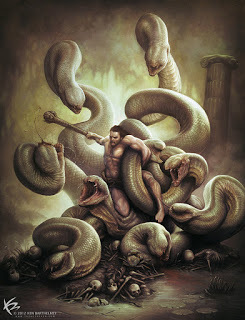 Heracles versus Hydra (© Ken Barthelmey/Deviantart.com - click here to view more of Ken's outstanding artwork in his deviantart gallery)
Heracles versus Hydra (© Ken Barthelmey/Deviantart.com - click here to view more of Ken's outstanding artwork in his deviantart gallery)This ShukerNature blog article is excerpted and expanded from my books Dragons: A Natural History and Dragons in Zoology, Cryptozoology, and Culture .
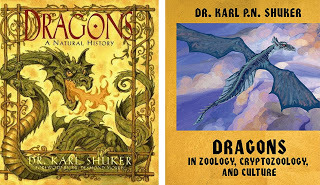
Published on August 10, 2015 15:06
August 6, 2015
EXPOSING THE CON IN ANACONDA - OR, HOW I MONSTERED A MONSTROUS SNAKE HOAX
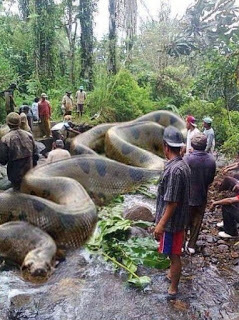 The online photo of a supposed gargantuan anaconda shot in Africa's Amazon River !! (photo-manipulated photograph's creator(s) unknown to me)
The online photo of a supposed gargantuan anaconda shot in Africa's Amazon River !! (photo-manipulated photograph's creator(s) unknown to me)Less than a month after debunking a trio of quasi-coloured mock pythons on ShukerNature (click here ), I was able to do the same to an even more outrageous hoax of the constrictor kind, this time involving a much-manipulated photograph of a green anaconda Eunectes murinus.
According to the record books, this anaconda species, the biggest known to science, rarely exceeds 20 ft long. However, many reports have been filed concerning a truly colossal form of anaconda supposedly existing amid the vast jungle swamplands and lagoons of Brazil and elsewhere in South America – the so-called sucuriju gigante – that allegedly far exceeds that size. In 1907, the subsequently-lost explorer Lieut.-Col. Percy Fawcett reputedly shot an estimated 62-ft specimen as it began to emerge from Brazil's Rio Abuna but couldn't salvage its monstrous form, and there have even been a few photographs made public that allegedly portray killed but never-preserved specimens of it (click here for my ShukerNature coverage of some examples). Could the subject of this present ShukerNature blog article be another such picture? I don't think so!
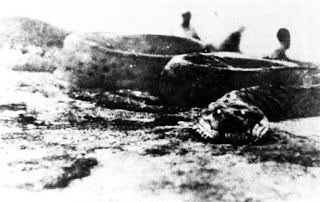 Photograph of a supposed 130-148-ft-long sucuriju gigante killed in or around 1932 at Manaos, Brazil, after having been captured alive (public domain)
Photograph of a supposed 130-148-ft-long sucuriju gigante killed in or around 1932 at Manaos, Brazil, after having been captured alive (public domain)During the late evening of 1 August 2015, I saw the startling photograph opening this ShukerNature article posted on Facebook friend Simon Hicks's 'Zen Yeti' FB group page. If it were genuine, the slain anaconda featured in it would be truly gargantuan – but was it genuine? The bizarre-looking, compressed coils of the snake didn't look natural, but any specimen that so dwarfed the humans standing around it (yet standing around it in a remarkably unconcerned, disinterested manner, I might add, for persons supposedly in such close proximity to so immense a snake, dead or otherwise) is always going to attract suspicion anyway.
It was linked to the timeline of one Rakesh Mintu Bjp, and when I clicked that link it took me to an annotated version of the photo on this person's timeline. I also checked online outside Facebook, and the photo and annotation had already appeared on many other websites during the past month or so. Consequently, neither had originated with Bjp – he had merely posted one such copy on his FB timeline, as had several other persons, I discovered, which means that the originator of the photo and annotation is currently unknown. Anyway, this is the annotation:
"World's biggest snake Anaconda found in Africa's Amazon river. It has killed 257 human beings and 2325 animals. It is 134 feet long and 2067 kgs. Africa's Royal British commandos took 37 days to get it killed."
Even if the photograph hadn't seemed dubious before (which it had!), after reading the garbled nonsense above I could now have no doubt whatsoever that it was a blatant, and exceedingly silly, hoax. And how did I know this? Where to begin?!!
Well, first and foremost: unless someone has sneaked it into Africa without telling me, the Amazon River is famous for being the largest in South America.
Secondly: unless someone had thoughtfully embedded a veritable 'kill-o-meter' inside the anaconda, how could anyone state so precisely how many humans and animals it had killed?
Thirdly: its length is more than 4 times the maximum confirmed length for any modern-day snake, and more than 3 times the maximum estimated length for the longest snake ever known from planet Earth – Titanoboa cerrejonensis, from the Palaeocene epoch in what is now Colombia, which is believed to have attained a maximum length of around 42 ft and a weight of around 2500 lb (1135 kg – only about half that of the photo's mega-anaconda).
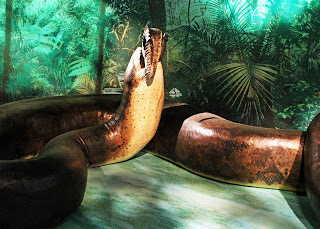 Titanoboa
life-sized model exhibit of the Smithsonian Institution, in the Natural History Museum © Ryan Quick/Wikipedia – Creative Commons Attribution 2.0 Generic License)
Titanoboa
life-sized model exhibit of the Smithsonian Institution, in the Natural History Museum © Ryan Quick/Wikipedia – Creative Commons Attribution 2.0 Generic License)Fourthly: there is no such regiment as Africa's Royal British commandos.
And fifthly: how on earth could it take 37 days to kill this snake, huge though it would have been if real? A concerted artillery or machine-gun salvo to its head would surely have dispatched it in a far shorter time period.
Just after midnight on 2 August, I posted on my 'Journal of Cryptozoology' FB group's page a link (click here - but only accessible to members of my FB group) to the photo as it appeared on Rakesh Mintu Bjp's timeline.
All that was now needed was the original, non-manipulated anaconda photograph to bring this sorry snake saga to a well-deserved end, and, after spending all of 2 minutes online using Google Image after having posted the fake photo's link on my 'Journal of Cryptozoology' page, I duly uncovered it, here , on a page dealing with anacondas, from a Brazilian biology website entitled 'Bio Curiosidades'. If you scroll down the page, it is the fifth photo from the top of the page.
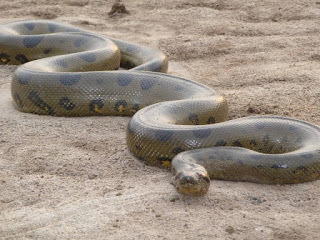 The original, non-manipulated anaconda photograph (©
www.ninha.bio.br
)
The original, non-manipulated anaconda photograph (©
www.ninha.bio.br
)The fake photograph had been produced by person(s) unknown simply by horizontally-flipping the above, original photograph to create a mirror-image version of it, then compressing it horizontally to yield those oddly-shaped coils, then either superimposing from a second photo the people and background around it, or, more probably, superimposing it upon a second photo containing the people and background.
After finding this photograph on the 'Bio Curiosidades' website, I duly posted on my 'Journal of Cryptozoology' FB group page a link to it, beneath my previous one linking to the fake photo. Case closed.
Thus endeth the tale of the giant anaconda that was merely a giant con.
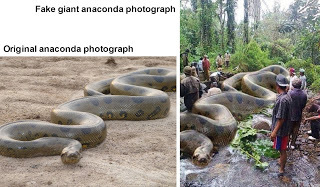 The original, non-manipulated anaconda photograph alongside the fake, photo-manipulated version; NB - I have horizontally-flipped the original photo here in order to provide a direct comparison of it alongside the fake photo (© www.ninha.bio.br for original photo/creator(s) of fake photo unknown to me)
The original, non-manipulated anaconda photograph alongside the fake, photo-manipulated version; NB - I have horizontally-flipped the original photo here in order to provide a direct comparison of it alongside the fake photo (© www.ninha.bio.br for original photo/creator(s) of fake photo unknown to me)
Published on August 06, 2015 09:23
July 28, 2015
THE LONG-NECKED SEAL IN CRYPTOZOOLOGY - PART 2: FROM SWAN-NECKED AND HIDDEN-NECKED TO TIZHERUK AND NESSIE
 Brian Froud's wonderful rendition of Peter Costello's proposed long-necked freshwater seal graces the cover of the 1975 Panther paperback edition of Costello's classic crypto-book In Search of Lake Monsters (© Peter Costello/Brian Froud/Panther Books)
Brian Froud's wonderful rendition of Peter Costello's proposed long-necked freshwater seal graces the cover of the 1975 Panther paperback edition of Costello's classic crypto-book In Search of Lake Monsters (© Peter Costello/Brian Froud/Panther Books)In Part 1 of this ShukerNature blog article (click here ), I investigated the candidature of an undiscovered species of giant long-necked seal as an identity for certain sea serpents, as promoted in particular by Drs Anthonie Oudemans and Bernard Heuvelmans. However, the concept of such a creature is not confined to the contemplation of marine cryptids, as now revealed.
MEGALOTARIA , MEET NESSIE!
Heuvelmans believed that it was his hypothesised long-necked seal, which he had formulated and dubbed Megalotaria longicollis in his seminal book Le Grand Serpent-de-Mer (1965), rather than any postulated form of surviving plesiosaur that was responsible for those water monsters yielding the now-iconic, vertically-held, periscope-like head-and-neck image firmly planted in everyone's mind when picturing water monsters (and most especially the Loch Ness monster), whether marine or freshwater in habitat, though in his book he confined himself to those cryptids on record from the seas and oceans.
Just under a decade later, however, one of Heuvelmans's cryptozoological disciples and longstanding correspondents, Irish author Peter Costello, produced what was very much a companion book to his mentor's sea serpent tome but concentrating its attention instead upon lake monsters, in particular Nessie. (Judging from a footnote in his sea serpent tome – "Which will appear in a separate book on 'monsters' of lochs, lakes, marshes and rivers – freshwater unknown animals" – apparently Heuvelmans had originally planned to prepare such a book himself, but subsequently assisted Costello in producing his own book instead.)
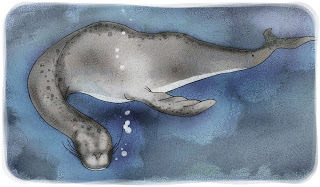 Nessie as a long-necked seal (© Robert Elsmore)
Nessie as a long-necked seal (© Robert Elsmore)Published in 1974, Costello's book was entitled In Search of Lake Monsters, and in this global study he followed much the same course as Heuvelmans did in his own, i.e. analysing an extensive collection of eyewitness reports of aquatic cryptids from around the world (but freshwater in this instance, with particular emphasis upon Scottish loch monsters), and then providing what he considered to be the most likely identification for them. Here, however, he diverged markedly from Heuvelmans, pursuing the Oudemans approach instead.
For whereas Heuvelmans had proffered a series of no less than nine different hypothetical cryptids as the collective solution to the sea serpent mystery, Costello bravely put forward only a single identity to explain virtually all of the lake monsters documented by him (including Nessie), diverse though they seemed to be in form, and therefore potentially inviting criticism of the kind that Oudemans's Megophias had attracted, i.e. that his solution was of the 'one-size-fits-all' variety – but that was not all. The single identity that he proposed was none other than Heuvelmans's very own giant long-necked seal, Megalotaria longicollis, thereby deeming it to be capable of living in freshwater habitats as well as in marine environments.
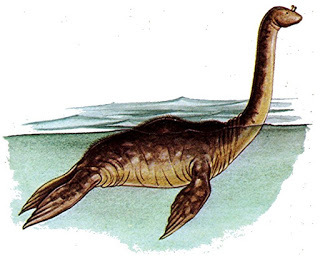 Artistic reconstruction of Megalotaria(Identity of artist/copyright holder unknown to me, so I would welcome receipt of appropriate credit details)
Artistic reconstruction of Megalotaria(Identity of artist/copyright holder unknown to me, so I would welcome receipt of appropriate credit details)As expected, therefore, for the most part Costello's description of this giant long-necked seal reiterated that of Heuvelmans for the same hypothetical species. However, he did also provide a few additional details, especially when specifically relevant to its inhabiting a freshwater domain, such as the assertion (rather than merely a speculation as offered by Heuvelmans for maritime Megalotaria) that it hunts by sonar, especially in stygian bodies of water like Loch Ness where vision is rendered largely or entirely superfluous, and that its hearing is therefore exceptionally sharp. As noted in Part 1 of this ShukerNature article, however, currently there is no conclusive evidence that pinnipeds do use sonar. He also claimed that it gives vent to a sharp staccato cry that sounds like a sea-lion's bark.
According to Costello, therefore, Nessie is merely a lake-dwelling long-necked seal, a freshwater-confined representative of Heuvelmans's marine Megalotaria, not even sufficiently distinct, despite its different habitat, to warrant any taxonomic delineation from the latter creature. Yet if this were true, why have other maritime pinnipeds only rarely or never established exclusively freshwater intraspecific populations? The only notable examples are two totally freshwater subspecies of the ringed seal Pusa(=Phoca) hispida – namely the greatly-endangered Saimaa seal P. h. saimensis (confined entirely to Finland's Lake Saimaa) and the Ladoga seal P. h. ladogensis (confined entirely to Russia's Lake Ladoga) – and some non-taxonomically discrete colonies of the common seal Phoca vitulinain a few lakes, such as Alaska's Lake Iliamna (already well-known to monster seekers for the giant fishes that allegedly inhabits its voluminous waters) and certain lakes in Quebec (a few researchers do elevate these Canadian individuals to the rank of a valid subspecies of common seal, known as the Ungava seal P. v. mellonae).
For the most part and with the vast majority of pinniped species (particularly the bigger ones), however, colonisation of freshwater simply does not occur. Yet it's not as if they never find their way inland from the sea – on the contrary, every year there are confirmed reports of seals in various rivers across the UK, for instance, and there are even verified records of specimens of known seal species in Loch Ness itself. However, whereas these have not led to the establishment of landlocked freshwater seal colonies (despite being much smaller than Megalotaria and therefore enabling a given volume and prey content of freshwater to accommodate and sustain more specimens of these seals than would be the case with a giant long-necked seal), according to the freshwater long-necked seal hypothesis the marine Megalotaria has somehow managed to accomplish this feat in numerous lakes all across the world.
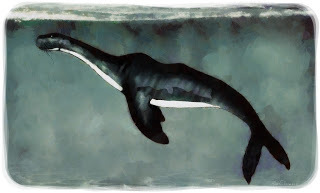 Reconstructing Nessie as Megalotaria(© Robert Elsmore)
Reconstructing Nessie as Megalotaria(© Robert Elsmore)But how could this particular pinniped species (always assuming that it does exist, of course!) have been so markedly successful at freshwater colonisation on an international scale, which would surely have involved some very visible migrations into freshwater at the onset, while also being so extraordinarily (indeed, inexplicably) adept at eluding all attempts by scientists and laymen alike to confirm its reality that not so much as a single skull or skeleton has ever come to scientific attention anywhere across its entire global distribution?
It is just about within the realms of possibility that amid the vastness of the world's seas and oceans the maritime Megalotariacan still evade scientific detection even in modern times, but how can its freshwater counterparts do the same, even when their lakes occur in close proximity to human habitation? For me the concept of Megalotaria, whether in the seas or (especially) in freshwater lakes, remains a particularly thorny one both to grasp and to retain.
THE RAPACIOUS TIZHERUK AND REPTILIAN SEALS
Much less familiar a cryptid than the longneck sea serpent (and its freshwater equivalents) is a second aquatic mystery beast whose identity may be that of a still-undiscovered species of long-necked seal.
The Bering Seaseparates Alaska from Far East Russia, and contains a number of islands, which have been and, in some cases, still are inhabited by members of the Inuit nation. According to their traditional lore, the seas around at least two of these islands are home to a very mysterious, and allegedly highly dangerous, marine creature known as the tizheruk to the Inuits that once lived on tiny King Island (the entire population had resettled on the Alaskan mainland by 1970), and as the pal rai yuk to those still living on the much larger Nunivak Island.
In his book Searching For Hidden Animals(1980), pioneering American cryptozoologist Dr Roy P. Mackal (until his retirement working in an official capacity as a biochemist at the University of Chicago) noted that the Inuits originally inhabiting King Island had provided a detailed account of the greatly-feared tizheruk to ethnologist Dr John White, formerly of Chicago's Field Museum of Natural History. Based upon this information, which he shared with Mackal, White revealed that only the tizheruk's head and neck are usually observed, which rear 7-8 ft out of the water. The head is snake-like in appearance, and on the rare occasions when the tail is visible it can be seen to bear a flipper at its end. These animals are generally encountered in the bay areas, less frequently in the open sea, and by placing their ears against the inside of their boats the Inuits can hear them coming up for air. Moreover, if they tap against their boats, the sound often attracts these animals, their curiosity bringing them closer as they seek to discover the tapping noise's nature – not that the Inuits make a point of attracting tizheruks, however, because they claim that these creatures will actively attack humans, and they recounted numerous episodes to White in which hunters had reputedly been killed by them.
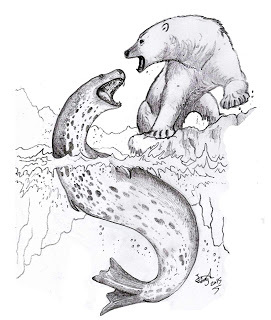 Artistic representation of the tizheruk (© Hodari Nundu)
Artistic representation of the tizheruk (© Hodari Nundu)Mackal considered that the tizheruk was most probably a scientifically-unknown species of long-necked seal, and went on to suggest a more specific identity for it that is extremely thought-provoking. Namely, a currently-undiscovered northern counterpart of the Antarctic's (in)famously aggressive leopard seal Hydrurga leptonyx (aka the sea leopard).
Generally up to 12 ft long, weighing as much as 1300 lb, named after its throat's spotting, possessing a visibly elongate neck (especially when striking prey or stretching it to look at something – click here to view a very famous and truly spectacular example of its neck-elongating behaviour), and belonging to the phocid (earless) family of seals, this formidable beast is the second largest seal species indigenous to the Antarctic – only the southern elephant seal Mirounga leonina is bigger. It is also voraciously carnivorous, second only to the killer whale as the Antarctic's top predator, preying upon creatures as large as fur seals and emperor penguins.
 A leopard seal stretching its neck to peer down into the sea, revealing how elongate it can become (© Jerzy Strzelecki/Wikipedia)
A leopard seal stretching its neck to peer down into the sea, revealing how elongate it can become (© Jerzy Strzelecki/Wikipedia)Moreover, those cryptozoologists favouring a reptilian rather than any mammalian identity for long-necked marine cryptids can take at least a crumb of comfort from the fact that, as commented upon by many scientists and laymen alike over the years, the leopard seal is startlingly reptilian in superficial appearance. This is especially true when seen on land, across which it can move at a remarkable speed by vertical wriggling.
In his book Sea Elephant: The Life and Death of the Elephant Seal (1952), British marine mammalogist L. Harrison Matthews penned the following memorable description of the leopard seal's very distinctive mode of terrestrial locomotion and its reptile-like mien while performing it, based upon his first-hand observation of this fascinating species at South Georgia:
And when it moves the resemblance [to a snake] is heightened for, unlike every other sort of seal, it holds the foreflippers closely pressed to the body and makes no use of them to help itself along – it wriggles with an up-and-down looping movement, pressing the chest and the pelvic region to the ground alternately.
 Leopard seal wriggling via vertical undulations across some ice with its front flippers pressed tightly and almost invisibly against its body (public domain)
Leopard seal wriggling via vertical undulations across some ice with its front flippers pressed tightly and almost invisibly against its body (public domain)One of the best descriptions of this rapacious mammal's surprisingly reptilian appearance coupled with its notoriously savage nature can be found in Alfred Lansing's book Endurance: The True Story of Shackleton's Incredible Voyage to the Antarctic (1959). It documents the history of polar explorer Sir Ernest Shackleton's third and final Antarctic expedition, the ill-fated Imperial Trans-Antarctic Expedition 1914-17, during which his ship Endurance was lost, resulting in the expedition having to spend months camped upon an ice floe hunting seals and penguins in order to survive. Lansing's book includes an evocative account of a terrifying attack upon expedition member Thomas Orde-Lees one day in March 1916 by a ferocious, very tenacious, and extremely cunning leopard seal of exceptional size:
Returning from a hunting trip, Orde-Lees, travelling on skis across the rotting surface of the ice, had just about reached camp when an evil, knob like head burst out of the water just in front of him. He turned and fled, pushing as hard as he could with his ski poles and shouting for Wild to bring his rifle.
The animal – a sea leopard – sprang out of the water and came after him, bounding across the ice with the peculiar rocking-horse gait of a seal on land. The beast looked like a small dinosaur, with a long, serpentine neck.
After a half-dozen leaps, the sea leopard had almost caught up with Orde-Lees when it unaccountably wheeled and plunged again into the water. By then. Orde-Lees had nearly reached the opposite side of the floe; he was about to cross to safe ice when the sea leopard's head exploded out of the water directly ahead of him. The animal had tracked his shadow across the ice. It made a savage lunge for Orde-Lees with its mouth open, revealing an enormous array of saw like teeth. Orde-Lees' shouts for help rose to screams and he turned and raced away from his attacker.
The animal leaped out of the water again in pursuit just as Wild arrived with his rifle. The sea leopard spotted Wild, and turned to attack him. Wild dropped to one knee and fired again and again at the onrushing beast. It was less than 30 feet away when it finally dropped.
Two dog teams were required to bring the carcass into camp. It measured 12 feet long, and they estimated its weight at about 1,100 pounds…The sea leopard's jawbone, which measured nearly 9 inches across, was given to Orde-Lees as a souvenir of his encounter.
In his diary that night, [fellow expedition member Frank] Worsley observed: "A man on foot in soft, deep snow and unarmed would not have a chance against such an animal as they almost bound along with a rearing, undulating motion at least five miles an hour. They attack without provocation, looking on man as a penguin or seal" .
If, as postulated by Mackal, a creature comparable in form and ferocity to the leopard seal existed in the Bering Strait, it would certainly make a plausible identity for the tizheruk.
 Leopard seal photographed on land in 1910 during the Terra Nova (British Antarctic) Expedition 1910-1912 (public domain)
Leopard seal photographed on land in 1910 during the Terra Nova (British Antarctic) Expedition 1910-1912 (public domain)Moreover, it is well known that leopard seals are very inquisitive. Quoting Matthews again from his elephant seal book:
Many a time when I have been fishing with the pram moored to the floating kelp I have brought a leopard [seal] right alongside by playing on its curiosity – if you tap gently and regularly with a rowlock on the gunwale or thwart you very soon find any leopard that may be near swimming alongside and looking up into your face.
Needless to say, this instantly recalls the identical activity carried out by the Inuits and the identical response to it given by the tizheruk.
Concluding his book's tizheruk coverage, Mackal speculated that this cryptid may resemble an enlarged version of the leopard seal in general appearance, but more specialised in that it either lacks forelimbs completely (as the Inuits seem not to mention them in their lore relating to it), or possesses reduced versions that it keeps folded tightly against its body when seen out of the water (just as the leopard seal does), rendering them virtually invisible and thus enhancing its superficially serpentine appearance.
Most southern hemisphere seals have a northern hemisphere counterpart of sorts, thereby making the leopard seal a noteworthy exception – unless its northern hemisphere counterpart is simply awaiting formal discovery, meanwhile living in scientific anonymity amid the chilling waters around certain islands in the Bering Sea?
SWAN-NECKED SEALS IN PINNIPED PREHISTORY
As noted at the beginning of Part 1 of this ShukerNature blog article, whereas plesiosaurs do at least have a fossil record substantiating their erstwhile existence, there is no evidence whatsoever in the currently-known fossil record for the existence at any time in pinniped history of an extreme, veritable giraffe-necked form like Megalotaria as predicted by Heuvelmans et al. as the identity of aquatic longnecks. Indeed, the only confirmed evidence for the former existence of anyseals possessing necks that were in any way longer than those of modern-day species is the series of fossil remains from the so-called swan-necked seals belonging to the extinct phocid genus Acrophoca.
 Acrophoca longirostris
skeleton at the Smithsonian Institution of Natural History (© Ryan Somma/Wikipedia)
Acrophoca longirostris
skeleton at the Smithsonian Institution of Natural History (© Ryan Somma/Wikipedia)But just how long were their necks, and were they long enough to justify their popular 'swan-necked' tag? Dating from the late Miocene to early Pliocene (approximately 7-4 million years ago), the first species to be discovered and named was Acrophoca longirostris, which was formally described by palaeontologist Dr Christian de Muizon in 1981, and whose fossils have been uncovered in Chile and Peru. It measured up to 5 ft in total length, and in Muizon's description he revealed that both the length of its cervical vertebrae and the total length of its cervical column exceeded those of all modern-day seals. Moreover, its cervical column length was approximately 21% of its total vertebral column length, whereas in modern-day seals it is generally 17-19%. Its skull was also noticeably lengthy (hence its species name, longirostris).
Yet although the neck of A. longirostris was proportionately longer, it was not as streamlined as the neck of what may well be its closest modern-day relative – the leopard seal. Moreover, its flippers were less well-developed, a second characteristic indicating that it was less adapted for swimming than the leopard seal, and that it may therefore have spent much of its time around the Pacific's coasts rather than out at sea (a behavioural preference that, if true, has been perpetuated by the leopard seal, in spite of its more specialised form for swimming).
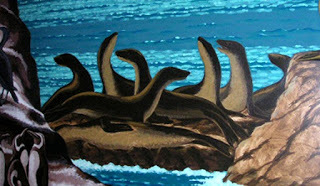 Acrophoca longirostris
depicted in a mural at the Staatliches Museum für Naturkunde Karlsruhe in Germany (© Markus Bühler)
Acrophoca longirostris
depicted in a mural at the Staatliches Museum für Naturkunde Karlsruhe in Germany (© Markus Bühler)As for its 'swan-necked' appellation: in a Tetrapod Zoology blog article of 4 February 2006 dealing with Acrophoca, palaeontologist Dr Darren Naish stated that because the necks of seals are sufficiently flexible to exhibit a marked lengthening effect when they lunge at prey, stretch, or spy-hop:
…when alive, Acrophoca would have been capable of looking even longer in the neck than we might think just from its fossils. But clearly it’s a stretch [pun intended?!] to imagine this animal as having a long long long neck like a swan, or a plesiosaur, so, sadly, ‘swan-necked seal’ really is a bit of an exaggeration.
In 2002, with fellow palaeontologist Dr Stig A. Walsh, Naish co-described what appeared to be a new, second Acrophoca species, based upon fossils retrieved in Chile, but they declined to give it a formal scientific name. This was because substantial new fossil material hailing from Peru suggested the presence of several additional Acrophocaspecies, so it was felt best to await their full description first. Interestingly, one of these new species had an even longer skull than A. longirostris, so it may have looked more unusual than the latter.
HIDDEN-NECK LONG-NECKED SEALS – A LITTLE-KNOWN PARADOX
Ironically, however, we do not even have to look back into prehistory to uncover bona fide, fully-verified long-necked seals. So far, this two-part article has been assessing attempts by various cryptozoologists down through the ages to propose as the identity of longneck aquatic cryptids the existence of a highly-specialised species of seal whose defining characteristic is its long neck. In reality, however, what is not readily realised is that science has already confirmed the existence of several such species – species, moreover, which are actually alive today. But how can this be? Allow me to explain.
With the notable exception of the leopard seal's well-delineated neck, in most modern-day seal species the neck is largely hidden, often concealed by blubber, to the point of seeming to be all but non-existent in certain forms. A close examination of such species' skeletons, conversely, reveals a very different – and extremely surprising – picture.
On 15 March 2013, American biologist Cameron A. McCormick's blog Biological Marginalia posted a fascinating article entitled 'The hidden necks of seals', containing a table of measurements obtained from a range of different pinniped species. For each species, the length of its neck was given as a percentage of the combined length of its thoracic and lumbar (T-L) vertebrae, and the results were quite remarkable to read. Using this comparison, the bearded seal Erignathus barbatus had the shortest neck among phocids, at only 21% T-L, whereas the harp seal Pagophilus groenlandicus boasted the longest neck, at 35% T-L – exceeding even the leopard seal's 29% T-L. As for otariids, the shortest neck was that of the Australian sea-lion Neophoca cinerea at 34.5% T-L, and the longest was that of the northern fur seal Callorhinus ursinus at 41% T-L.
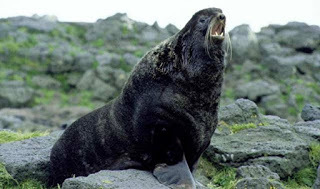 An adult bull specimen of the northern fur seal (public domain)
An adult bull specimen of the northern fur seal (public domain)But what was most significant was that even the shortest necks were actually much longer than they outwardly appeared to be in the living animal. So in a very real sense, some already-known, modern-day seal species are actually cryptic long-necked seals, or, to be precise, hidden-neck long-necked seals.
In view of this unexpected revelation, one can scarcely even begin to guess at what the neck percentage T-L value might be for a giraffe-necked, Megalotaria-type of long-necked seal – especially when we take into account (judging at least from the above data) that there may be an additional neck portion hidden from sight beneath blubber at its basal region. In fact, such an exceptionally long neck could well be of truly plesiosaurian proportions!
THE SEAL(S) OF APPROVAL
Prior to the establishment of the Journal of Cryptozoology in 2012, the appearance in a peer-reviewed academic journal of a paper dealing with cryptids was probably just as rare as the beasts documented in it. This is why, back in late 2008 (and in June 2009 online), the publication by the mainstream scientific journal Historical Biology of a paper contemplating the possible existence of still-undiscovered pinniped species was of particular note – and, one hopes, an indication of increasing mainstream approval for serious cryptozoological research.
Authored by Drs Darren Naish and Michael A. Woodley (the latter being a Royal Holloway, University of London postgraduate biology student at that time), both with well known cryptozoological interests, together with Royal Holloway computer scientist Dr Hugh P. Shanahan, it was entitled ‘How many extant pinniped species remain to be described?’. In it, the authors examined the description record of the pinnipeds using non-linear and logistic regression models in an attempt to ascertain the number of still-undescribed species, and they combined that work with an evaluation of cryptozoological data, featuring such alleged pinniped cryptids as the longneck sea serpent, the merhorse, Vancouver’s serpentiform Cadborosaurus, and the tizheruk.
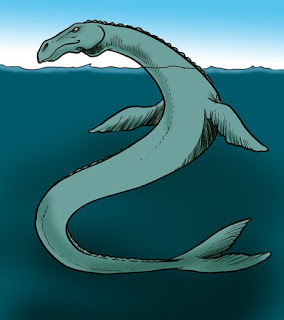 Artistic representation of Cadborosaurus as an exceedingly serpentiform pinniped-like cryptid (© Richard Svensson)
Artistic representation of Cadborosaurus as an exceedingly serpentiform pinniped-like cryptid (© Richard Svensson)From the results obtained, they revealed that three possibly new, currently undescribed species of pinniped match their statistical expectations, but even these, the authors felt, would need to possess some exceptional characteristics if they do indeed exist.
A giraffe-proportioned neck combined with huge body size would certainly be exceptional, but for all the reasons presented and assessed in this two-part article, it seems to me at least that these would be highly improbable characteristics for a seal species to possess and yet remain undiscovered by science, especially if it did indeed occur in both marine and freshwater habitats. Consequently, I am not expecting to witness the formal scientific discovery of a Megalotaria-type pinniped any day soon – but how I would love to be proved wrong!
AND FINALLY – THE ONE THAT WON'T GO AWAY
As readers of this article will no doubt have realised by now, I am definitely not a proponent of the giraffe-necked, Megalotaria-type giant seal as an identity for any aquatic cryptid. Consequently, I would like nothing more than to jettison it as far away from my thoughts as possible when reviewing such creatures, but there is one tantalising case that always prevents me from doing so – and this is it.
The Orkney Islandsand Caithness on the mainland of northern Scotland are separated by a strait of seawater known as the Pentland Firth, which is a popular habitat for seals throughout the year. Two species are known to occur here, the common seal and the grey seal Halichoerus grypus – but at about 9.30 am on or around 5 August 1919, off the Orkney island of Hoy, what seems to have been a third, and dramatically different, seal species also made an appearance in this strait, to the astonishment of its eyewitnesses. These consisted of a holidaying lawyer named J. Mackintosh Bell and some local cod fishermen friends of his whom he had chosen to work with on their boat while visiting the Orkneys. His friends had seen the creature before, were very perplexed as to what it might be, and had actually just begun to tell him about it in the hope that he may be able to identify what it was when the subject of their conversation abruptly appeared, not far away from the boat that they were in.
Lieutenant-Commander Rupert T. Gould of Britain's Royal Navy investigated and documented aquatic monsters in his spare time, and after learning about this sighting he contacted Bell and asked him for full details. Bell duly forwarded an in-depth account, which Gould later published in slightly abbreviated form within his book The Case For the Sea-Serpent (1930). Four years later, moreover, Gould wrote the first comprehensive study of Nessie, entitled The Loch Ness Monster and Others, spending several days at the loch, travelling around it on his motorbike, and interviewing many eyewitnesses during his researches for this book.
 The Case For the Sea-Serpent
, Singing Tree Press's 1969 reprint (© Singing Tree Press)
The Case For the Sea-Serpent
, Singing Tree Press's 1969 reprint (© Singing Tree Press)As far as I am aware, Bell's original, full-length account has never appeared in print, but here is the slightly abbreviated version of it that Gould published in his sea serpent book:
The very first day I was there, I think it was about 5 August, I went afloat with a crew of four at about 9.30 a.m. for the purpose of firstly lifting lobster creels and then for cod fishing. On making our way to the creels, which had been set in a line between Brims Ness and Tor Ness, my friends said "We wonder if we will see that sea monster which we often see, and perhaps you will be able to tell us what it is."
We got to the creels, hauled some, and were moving slowly with the motor to another, when my friends said very quietly "There he is."
I looked, and sure enough about 25—30 yards from the boat a long neck as thick as an elephant's fore leg, all rough-looking like an elephant's hide, was sticking up. On top of this was the head which was much smaller in proportion, but of same colour. The head was like that of a dog, coming sharp to the nose. The eye was black and small, and the whiskers were black. The neck, I should say, stuck about 5-6 ft., possibly more, out of the water.
The animal was very shy, and kept pushing its head up then pulling it down, but never going quite out of sight. The body I could not then see. Then it disappeared, and I said "If it comes again I'll take a snapshot of it." Sure enough it did come and I took as I thought a snap of it, but on looking at the camera shutter, I found it had not closed owing to its being swollen, so I did not get a photo. I then said "I'll shoot it" (with my .303 rifle) but the skipper would not hear of it in case I wounded it, and it might attack us.
It disappeared, and as was its custom swam close alongside the boat about 10 feet down. We all saw it plainly, my friends remarking that they had seen it many times swimming just the same way after it had shown itself on the surface. My friends told me that they had seen it the year before just about the same place. It was a common occurrence, so they said. 'That year (1919) was the last of several years in which they saw it annually. It did not show itself again for two or three years, and then it was only seen once. As to its body, it was, seen below the water, dark brown, getting slightly lighter as it got to the outer edge, then at the edge appeared to be almost grey. It had two paddles or fins on its sides and two at its stern. My friends thought it would weigh 2 or 3 tons, some thinking 4 to 6. Not only my friends, but others, lobster fishing, got many chances of seeing it. . .
I may say that since 1919 all cod and other deep-sea coarse fish have left the Pentland Firth. I think the reason is that such monsters frequent the rocky caves, which are always covered by deep water. My friends think the animal may have been killed by a passing steamer, but I think it is possibly a native of warmer seas, and that if we get a really hot summer it will be seen again.
Bell also furnished Gould with two sketches that he had drawn of the animal, one showing how it looked when swimming underwater, plus a map of the approximate location where they had seen it. This was on the northern side of the Pentland Firth, roughly 1.6 miles north-westward of Tor Ness, the southern point of the Orkney island of Hoy, and about an eighth of a mile offshore, in some 20 fathoms of water.
 Bell's sketch of the creature that showed its head and very long neck (public domain)
Bell's sketch of the creature that showed its head and very long neck (public domain)When Gould wrote to Bell requesting the approximate dimensions of the creature, Bell provided the following additional details:
. . . Dimensions. Neck, so far as seen, say 6—7 feet. Body never seen when neck straight up, but just covered by the water. You could detect the paddles causing the water to ripple. When under water, swimming, the body, I think, to the end of the tail flappers would be about 12 ft. long - and, if the neck were stretched to say 8ft., the neck and body 18—20 ft. long. The skipper of the boat remarked that sometimes the top of the head, when seen from a boat vertically, was a bright red. Neck thickness say 1 foot diameter : Head very like a black retriever — say 6" long by 4" broad. Whiskers black and short. Circumference of body say 10-11 feet, but this I am not sure of, as I never saw all round it, but it would be 4-5 ft. across the back. . .
Needless to say, everything about this creature, both in Bell's verbal accounts and in his sketches, screams out "Seal!!" – very long neck notwithstanding.
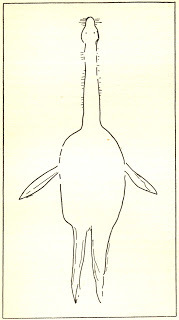 Bell's sketch of the creature that showed its appearance when swimming underwater (public domain)
Bell's sketch of the creature that showed its appearance when swimming underwater (public domain)When documenting it in his 2007 review of the long-necked seal concept, Robert Cornes stated: "If this account is true and there appears no reason to think otherwise, then it is arguably the most convincing for the existence of a seal with a long neck". Indeed it is, because if Bell's testimony and sketches are accurate, it is difficult to comprehend how the creature that he and his friends saw could have been anything other than a seal – and an exceptionally, extraordinarily long-necked one at that.
It is for this reason, if for no other, that the concept of the long-necked seal, even in its most bizarre, giraffe-necked manifestation, continues to frustrate and fascinate me in equal measure, and seems destined to do so for a long time to come.
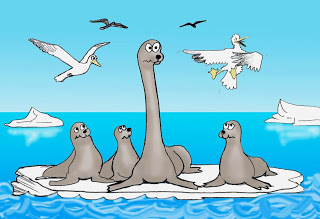 A delightful cartoon seeing the funny side of the long-necked seal, in every sense! (© William Rebsamen)
A delightful cartoon seeing the funny side of the long-necked seal, in every sense! (© William Rebsamen)This ShukerNature blog article is excerpted from my forthcoming book, Here's Nessie!: A Monstrous Compendium from Loch Ness .
SELECT BIBLIOGRAPHY
CHAMPAGNE, Bruce A. (2007). A classification system for large, unidentified marine animals based on the examinations of reported observations. In: HEINSELMAN, Craig (Ed.), Elementum Bestia: Being an Examination of Unknown Animals of the Air, Earth, Fire and Water. Crypto (Peterborough), pp. 144-172.
COLEMAN, Loren and HUYGHE, Patrick (2003). The Field Guide to Lake Monsters, Sea Serpents, and Other Mystery Denizens of the Deep. Tarcher/Penguin (New York).
CORNES, Robert (2007). The seal serpent: the case for the surreal seal. In: DOWNES, Jonathan (Ed.), CFZ 2007 Yearbook(CFZ Press: Bideford), pp. 83-199.
COSTELLO, Peter (1974). In Search of Lake Monsters. Garnstone Press (London).
GOULD, R[upert].T. (1930). The Case For the Sea=Serpent. Philip Allan (London).
GREW, Nehemiah (1681). Musaeum Regalis Societatis: Or a Catalogue and Description of the Natural and Artificial Rarities Belonging to the Royal Society and Preserved at Gresham Colledge [sic]. W. Rawlins (London).
HEUVELMANS, Bernard (1965). Le Grand Serpent-de-Mer.Plon (Paris).
HEUVELMANS, Bernard (1968). In the Wake of the Sea-Serpents. Rupert Hart-Davis (London).
LANSING, Alfred (1959). Endurance: The True Story of Shackleton's Incredible Voyage to the Antarctic. Hodder and Stoughton (London).
MACKAL, Roy P. (1980). Searching For Hidden Animals: An Inquiry Into Zoological Mysteries. Doubleday (Garden City).
MAGIN, Ulrich (1996). St George without a dragon: Bernard Heuvelmans and the sea serpent. Fortean Studies, 3: 223-234.
MARDIS, Scott (1996). Sealing Champ's fate: more thoughts on the lake monster. Vox, 2 (No. 25; 7 August).
MATTHEWS, L. Harrison (1952). Sea Elephant: The Life and Death of the Elephant Seal. MacGibbon and Kee (London).
McCORMICK, Cameron A. (2013). The hidden necks of seals. Biological Marginalia, https://biologicalmarginalia.wordpres... 15 March.
MUIZON, Christian de (1981). Les vertébrés fossiles de la formation Pisco (Pérou). Première partie: deux nouveaux Monachinae (Phocidae, Mammalia) du Pliocene de Sud-Sacaco. Travaux de l’Insitut Français d’Études Andines, 22: 1-161.
NAISH, Darren (2001). Sea serpents, seals and coelacanths: an attempt at a holistic approach to the identity of large aquatic cryptids. Fortean Studies, 7: 75-94.
NAISH, Darren (2006). Swan-necked seals. Tetrapod Zoology, http://darrennaish.blogspot.co.uk/200... 4 February.
OUDEMANS, Anthonie C. (1892). The Great Sea-Serpent: An Historical and Critical Treatise. E.J. Brill (Leiden).
PARSONS, James (1751). A dissertation upon the class of the Phocae Marinae. Philosophical Transactions, 47: 109-122.
SHUKER, Karl P.N. (1995). In Search of Prehistoric Survivors. Blandford (London).
TAYLOR, Michael P.; WEDEL, Mathew J.; and NAISH, Darren (2009). Head and neck posture in sauropod dinosaurs inferred from extant animals. Acta Palaeontologica Polonica, 54(2): 213-220.
WALSH, Stig A. and NAISH, Darren (2002). Fossil seals from late Neogene deposits in South America: a new pinniped (Carnivora, Mammalia) assemblage from Chile. Palaeontology, 45: 821-842.
WOODLEY, Michael A. (2008). In the Wake of Bernard Heuvelmans. CFZ Press (Bideford).
WOODLEY, Michael A; NAISH, Darren; and SHANAHAN, Hugh P. (2008). How many extant pinniped species remain to be described? Historical Biology, 20(4): 225-235.
* * * * *
Published on July 28, 2015 17:29
July 27, 2015
THE LONG-NECKED SEAL IN CRYPTOZOOLOGY - PART 1: GIRAFFE SEALS AND SEA SERPENTS
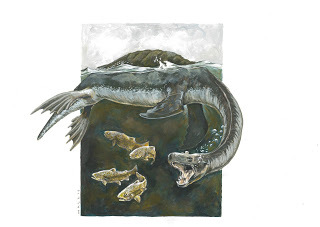 Restoration of the Loch Ness monster as a long-necked seal (© Anthony Wallis)
Restoration of the Loch Ness monster as a long-necked seal (© Anthony Wallis)Although many mainstream palaeontologists may shudder at the merest thought of it, the Loch Ness monster's most readily-conceived public image will always be that of a typical plesiosaur – all neck, tail, and paddled limbs. Lurking in its shadow, never too far from scientific consciousness but a million miles away from popular recognition, however, is a second cervically-endowed yet very different identity candidate – the long-necked seal. Yet whereas the plesiosaur's at least erstwhile reality is unequivocally validated by the fossil record (albeit one in which this reptilian lineage is currently curtailed at a point over 60 million years ago), tangible evidence for the existence at any point in our planet's history of the kind of veritable giraffe-necked pinniped required to satisfy a mammalian identity for Nessie and other comparable 'periscope-profile' aquatic cryptids is conspicuous only by its absence. Indeed, to all intent and purpose there is no more proof for the reality of the long-necked seal than there is for the Loch Ness monster itself. So. when and how did this hypothetical horror come into theoretical being, and why does it persist in casting its nebulous shadow over the much more romantic (if no more realistic?) image of its plesiosaurian rival? It's time to find out!
A LONG-FORGOTTEN LONG-NECKED SEAL AT THE ROYAL SOCIETY
Although in modern times the concept of the long-necked seal as a zoological reality has been promoted most visibly by the cryptozoological triumvirate of Oudemans, Heuvelmans, and Costello, a mysterious creature not only fitting its description but actually referred to by that very same name had been documented as far back as the 1600s, but was completely overlooked by cryptid chroniclers until the 1990s. This was when American cryptozoologist Scott Mardis made a highly significant discovery, by spotting its long-forgotten description on microfiche at the University of Vermont, after which he duly brought this surprising but potentially very important beast to present-day public attention at long last via an article published on 7 August 1996 in a Vermont weekly magazine entitled Vox.
 Scott's Vox article - click it to enlarge for reading purposes (© Scott Mardis/Vox)
Scott's Vox article - click it to enlarge for reading purposes (© Scott Mardis/Vox)In 1681, botanist Dr Nehemiah Grew published a catalogue of curiosities that could be found at that time in the museum of London's Royal Society. It was entitled Musaeum Regalis Societatis: Or a Catalogue and Description of the Natural and Artificial Rarities Belonging to the Royal Society and Preserved at Gresham Colledge [sic], and among the many specimen descriptions penned by Grew that it contained was one of a still-unidentified form of long-necked seal, based upon a preserved skin from an apparently young individual of this mystifying creature. Specifically referring to it as 'the long-necked seal', Grew described it on p. 95 of his catalogue as follows:
THE LONG-NECK'D SEAL. I find him no where distinctly mention'd. He is much slenderer than either of the former [two other pinnipeds documented by him earlier – see below]. But that wherein he principally differs, is the length of his Neck. For from his Nose-end to his fore-Feet, and from thence to his Tail, are the same measure. As also in that instead of fore-Feet, he hath rather Finns [sic]; not having any Claws thereon, as have the other kinds.
Conversely, in most known species of pinniped the length of their neck is only about half the length of their lower body.
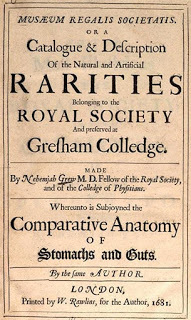 Title page of Dr Nehemiah Grew's Musaeum Regalis Societatis (public domain)
Title page of Dr Nehemiah Grew's Musaeum Regalis Societatis (public domain)Grew's description was subsequently reiterated by James Parsons in a paper on marine seals published by Philosophical Transactions, a Royal Society journal, on 1 January 1751. In it, he listed various known species, and he included the long-necked seal within this list. Here is Parsons's slightly expanded version of Grew's original description of it:
He is much slenderer than either of the former; but that, wherein he principally differs, is the length of his neck; for from his nose-end to his fore-feet, and from thence to his tail, are the same measure; as also in that, instead of his fore-feet, he hath rather fins; not having any claws thereon, as have the other kinds. The head and neck of this species are exactly like those of an otter…That before described [the long-necked seal], was 7 feet and an half in length; and, being very young, had scarce any teeth at all.
Accompanying its description, moreover, was an illustration of this unidentified creature (reproduced in Scott's Vox article), which portrayed it with a decidedly elongate neck, and was captioned 'the long necked seal or sea-calf'. It was depicted alongside two other seals (the same two as described by Grew prior to the long-necked seal).
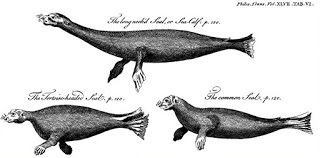 Depiction of the Royal Society's long-necked seal specimen in Parsons's 1751 paper (public domain)
Depiction of the Royal Society's long-necked seal specimen in Parsons's 1751 paper (public domain)One of these two was termed 'the common seal' (i.e. Phoca vitulina), and was readily identifiable as this species. The other one, conversely, was more perplexing, being dubbed 'the tortoise-headed seal' (and which must wait for its own review elsewhere!). In his seal listing at the end of his paper, Parsons noted that the long-necked seal could be found "on the shores of divers[e] countries".
Be that as it may, no additional skins of long-necked seals have been forthcoming since the time of Grew and Parsons – their specimen thus being unique. So where is this zoologically-priceless skin today – what may well be the only physical evidence of a cryptozoological long-necked seal ever obtained by science? Tragically, no-one knows – like so many other remarkable specimens of mysterious, unidentified creatures, it has seemingly been lost, vanished into that great void where cryptid material seems irresistibly and inexorably drawn, never to be seen again.
FROM OUDEMANS TO HEUVELMANS – AND FROM MEGOPHIAS TO MEGALOTARIA
Although, therefore, as revealed above, this was not its earliest appearance in the historical chronicles, the long-necked seal first made cryptozoological headlines during the early 1890s. This was when Dutch zoologist and passionate sea serpent investigator Dr Anthonie C. Oudemans envisaged just such a beast as the answer to one of the greatest riddles in 19th-Century natural history – the elusive identity of the even more elusive 'great sea serpent'.
After analysing numerous sea serpent reports originating from seas all around the world and dating back centuries in some cases, Oudemans considered that their most plausible explanation was the scientifically-undiscovered presence of an enormous species of seal, boasting a cosmopolitan distribution, and morphologically distinguished from all presently-known species not only by its huge size (capable of growing up to 200 ft long) and long slender tail (a very unseal-like feature), but, in particular, by its very sizeable, elongate neck (which bore a noticeable mane in the male). In illustrations depicting its likely appearance in life, it looked very like a mammalian plesiosaur (or a plesiosaurian mammal).
Oudemans even gave this seagoing marvel its very own taxonomic binomial – Megophias megophias, thereby classifying it as a new species within a (now-defunct) genus that had been coined back in 1817 by French-American naturalist and passionate sea serpent investigator Constantine Samuel Rafinesque-Schmaltz in his published description of an uncaptured snake-like marine cryptid responsible for a spate of reported sea serpent sightings off Gloucester, New England, at that time (Megophias translates as 'big snake').
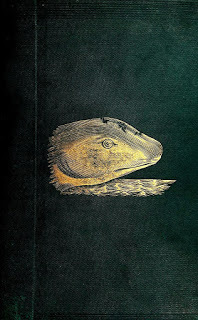 Front cover of the first edition of Oudemans's The Great Sea-Serpent, featuring a gilt representation of the head of the Daedalus sea serpent (public domain)
Front cover of the first edition of Oudemans's The Great Sea-Serpent, featuring a gilt representation of the head of the Daedalus sea serpent (public domain)In 1892, Oudemans published his extensive study and conclusions in his now-classic tome The Great Sea-Serpent, which makes fascinating if frustrating reading. For at the risk of perpetuating further this unintentional bout of alliteration, his resolution of the sea serpent problem was fatally flawed. Anyone reading the vast array of sightings documented by him can readily perceive that the beasts observed belong to a variety of discernibly distinct types. Yet Oudemans, inexplicably, chose to shoe-horn them all into one, resulting in his creation of M. megophias as a 'one-size-fits-all' solution that was doomed to failure when attempting to convince mainstream scientists already highly suspicious of sea serpent reality that it was truly the taxonomic alter ego of this incognito maritime enigma.
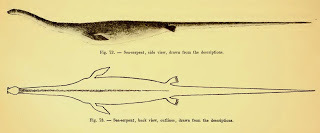 Oudemans's illustrations of his proposed long-necked (and long-tailed) mega-seal Megophias megophias(public domain)
Oudemans's illustrations of his proposed long-necked (and long-tailed) mega-seal Megophias megophias(public domain)And so, inevitably, Megophias floundered, Oudemans's ill-fated composite creation garnering little in the way of zoological credibility for itself, and rapidly sinking without trace into the gloomy abyss of scientific obscurity instead. And there it would linger, unloved and unlooked-for, all but forgotten for almost three-quarters of a century, until the long-necked seal hypothesis was finally retrieved, revived, and reconstituted in a very different form as part of a much more comprehensive, and complex, sea serpent classification conceived by a certain Belgian cryptozoologist – Dr Bernard Heuvelmans.
Not only did Heuvelmans share a similar surname with Oudemans, when his own magnum opus on the sea serpent mystery was first published, in 1965 in French, it likewise shared the same name as Oudemans's – Le Grand Serpent-de-Mer ('The Great Sea-Serpent'). (Three years later, somewhat abridged and combined with a greatly-shortened version of an originally separate book on the giant squid and giant octopus, it was published in English as In the Wake of the Sea-Serpents.) And even his postulated long-necked mega-seal had a similar generic name to Oudemans's Megophias– namely, Megalotaria. But that is where the similarities ended.
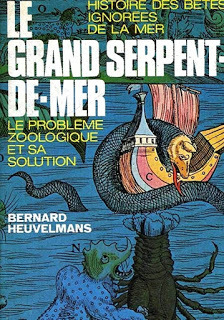 First edition of Heuvelmans's tome Le Grand Serpent-de-Mer (© Plon)
First edition of Heuvelmans's tome Le Grand Serpent-de-Mer (© Plon)Not making the same mistake as his near-namesake predecessor, in his grand scheme of sea serpent classification Heuvelmans conceived no less than nine distinct categories. Each constituted a different, scientifically-undiscovered species, and which he believed collectively explained all of the major sea serpent sightings reported from around the world down through history.
These hypothesised species were: a giant yellow tadpole-like creature of indeterminate taxonomic affinities; a gigantic 'super eel' (and/or a very elongate form of shark); a marine reptile resembling a prehistoric mosasaur or a flippered crocodilian; an immense sea turtle; a many-humped serpentine zeuglodont-like cetacean; an armoured anomaly that he considered to be another zeuglodont due to his mistaken belief that armoured zeuglodonts were known from the fossil record (in reality, these were later exposed to be normal zeuglodonts whose remains had been found in association with armour-like scales derived from other, entirely unrelated fossil creatures); an exceedingly primitive stem cetacean of superficially otter-like form but much greater size and still possessing four limbs (his so-called 'super-otter'); and two separate types of pinniped, both of which were either tailless or near-tailless, like all modern-day species.
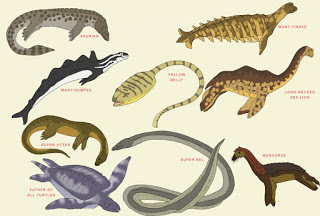 Representations of Heuvelmans's nine categories of sea serpent (© Tim Morris)
Representations of Heuvelmans's nine categories of sea serpent (© Tim Morris)One of these pinnipeds, with a shorter neck, huge eyes, and a very noticeable mane, was dubbed by him the merhorse. The other, which combined the body and limbs of a typical otariid or eared seal (i.e. fur seals and sea-lions, possessing external ears) with an exceedingly long, giraffe-proportioned neck, he dubbed the long-necked (nowadays shortened to longneck), and proposed for it the binomial name Megalotaria longicollis('long-necked big otariid'). (Incidentally, in their 2003 book The Field Guide to Lake Monsters, Sea Serpents, and Other Mystery Denizens of the Deep, veteran American cryptozoologists/fortean writers Loren Coleman and Patrick Huyghe merged the merhorse and longneck into a single sea serpent type, which they dubbed the waterhorse.)
After more than 70 years in zoological – and cryptozoological – exile, the long-necked seal was back!
 Restoration of the long-necked seal Megalotaria longicollis in Heuvelmans's book, based upon his identikit description of it (© Bernard Heuvelmans/Alika Watteau/Plon)
Restoration of the long-necked seal Megalotaria longicollis in Heuvelmans's book, based upon his identikit description of it (© Bernard Heuvelmans/Alika Watteau/Plon)From analysing 82 eyewitness accounts of alleged long-necked sea serpents, of which he deemed 48 to be certain, in his book Heuvelmans produced the following 'identikit' description of what he considered the likely morphology of this alleged cryptid to be:
A sea-animal of fairly large size, much bigger than the biggest pinnpeds and recognizable by its very long slender neck. Its general shape can vary greatly because of its thick layers of fat: sometimes cigar-shaped, sometimes serpentine when swimming fast, it may seem thick and stumpy when hunched up on itself. The relatively small head is round in shape with a somewhat tapering muzzle, sometimes like that of a seal or dog, sometimes like that of a horse, camel or giraffe. This apparent contradiction in testimony is doubtless due to the head lengthening with age, as is the rule among mammals.
The eyes are very small and can hardly be seen except from very close. In young ones there are a few whiskers on the muzzle. Two little horns can sometimes be seen on the head; these are probably erectile tubes arising round the nostrils. As the eyes are practically invisible, it is hard to place these tubes exactly in relation to them: at all events they rise from the top of the head. They would enable the animal to come to the surface to breathe without lifting its head out of the water, an arrangement like the skin-diver's schnorkel [sic]…
The neck is long and cylindrical; it is extremely flexible and can bend in any direction, especially in a vertical plane like a swan's. It may also stick perpendicularly out of the water like a telegraph pole. It has no mane, but a sort of collar, perhaps a fold in the skin, behind the head is sometimes mentioned.
The body is massive, thick and covered with rolls of fat so that it may, according as it bends, show one, two or three big dorsal humps, the middle of the three being the biggest. It has been suggested that these humps are inflatable air-sacs. This is possible, and the explanation cannot be excluded, but there is no need for any such theory in this case.
The spine forms a slight ridge all along its length, this may be due to a hairy crest or be accentuated by one.
There are four webbed feet, the front pair of which are often visible when the animal stands up vertically in the water, as the pinnipeds often do…When the hind feet are spread out in the same plane, they may sometimes look like a horizontal bilobate tail, as in the cetaceans. But they can also be held face to face, as the pinnipeds often do, and may then look like a fish's tail…
There does not seem to be much tail: at the very most it is a mere stump.
The skin looks smooth when it is wet and shining, but seen from close to it looks wrinkled and rough, like a walrus's or an elephant's. It is very dark brown on top, with black, grey or whitish mottling, while the underneath of the belly is dirty yellow and much lighter.
…Apart from one or two extravagant estimates of 200 feet or so, almost all the witnesses give a length between 15 and 65 feet – 60 feet often being given in round figures. There is, it is true, a series of witnesses who give lengths between 65 and 100 feet, and even as much as 120, but they seem to be influenced by the preconceived idea that it is a serpent, a plesiosaur, or even Oudemans's Megophias, and to assume it must have a tail as long as its neck and so extrapolate unjustifiably from the visible part of the body.
Speaking of extrapolating unjustifiably: I first read Heuvelmans's book over 30 years ago, and back then it seemed to me to be a work of superlative, near-genius zoological detection, worthy of the peerless if fictitious Sherlock Holmes himself (and indeed, Heuvelmans has actually been referred to as the Sherlock Holmes of zoology). In later years, conversely, as my own knowledge of cryptozoology, its methods, and its shortcomings increased, I re-read the book several times, and on each occasion with increasing scepticism regarding Heuvelmans's bold claims and intricate deductions.
 A modern-day representation of Heuvelmans's longneck sea serpent category (© Tim Morris)
A modern-day representation of Heuvelmans's longneck sea serpent category (© Tim Morris)Even taking into account the fact that he rejected many eyewitness reports as implausible, I personally feel that he nonetheless placed far too much emphasis upon the literal content of those that he did accept, i.e. he drew in-depth, often excessive, conclusions from the descriptions contained in those latter reports that, in my view, cannot be justified, because we simply have no idea just how accurate those descriptions really were.
From my own experiences of eyewitness accounts, I am well aware of the all-too-human failure of observers lacking a detailed knowledge of animals to describe with any notable degree of zoological accuracy the physical appearance of creatures that were unfamiliar to them (especially if doing so entirely from memory, and/or from a time some distance removed from the actual event and/or if they had encountered the creatures unexpectedly). This also applies to size estimates proffered by them. Such failure is surely responsible in no small way for the not-inconsiderable variations in eyewitness descriptions noted by Heuvelmans in his extensive and inordinately-detailed Megalotaria identikit account quoted by me above (and which is precisely why I reproduced it verbatim), most notably regarding the shape of its head, rather than (as he evidently if rashly believed) such variations being explicable entirely via anatomical or age-related phenomena.
In short, I believe that Heuvelmans placed far too much reliance upon the literal accuracy of eyewitness reports and far too little upon the likelihood that much of what was described in them were artefacts arising from poor zoological knowledge, inaccurate description, and flawed recollection.
 A third representation of Megalotaria longicollis (© Stefano Maugeri/Gruppo Criptozoologia Italia)
A third representation of Megalotaria longicollis (© Stefano Maugeri/Gruppo Criptozoologia Italia)In addition, following a close examination of Heuvelmans's sea serpent researches and his resulting nine-category classification system, German cryptozoologist Ulrich Magin argued in an extensive Fortean Studies paper from 1996 that far from being the outcome of an objective data analysis, Heuvelmans's sea serpent categories are subjective and predetermined, and that they don't actually function successfully when applied to individual cases. Magin's opinion is shared by British palaeontologist and cryptozoological author Dr Darren Naish, as expressed in a Fortean Studies paper of his own, from 2001.
Ideally, to avoid any subjectivity creeping into the data analysis when attempting to distinguish morphological categories of sea serpent present in the data, the analyser should be doing so blind, i.e. using eyewitness descriptions alone as the basis for creating sea serpent categories, not taking into account geographical localities or any other factors like Heuvelmans did. However, the analyser would then be vulnerable to falling foul of the uncertainty that invariably surrounds the accuracy of anecdotal evidence. For the most comprehensive examination and assessment of Heuvelmans's sea serpent classification, see Dr Michael A. Woodley's book In the Wake of Bernard Heuvelmans (2008).
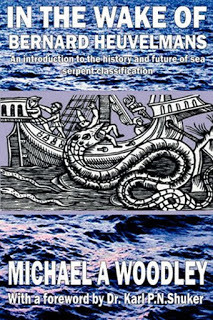 In the Wake of Bernard Heuvelmans
(© Dr Michael A. Woodley/CFZ Press)
In the Wake of Bernard Heuvelmans
(© Dr Michael A. Woodley/CFZ Press)All of the above criticisms also apply in relation to Heuvelmans's equally extensive, confident description of Megalotaria's behaviour, yet once again based solely upon eyewitness testimony. According to his interpretation of such sources, this elusive giraffe-necked maritime cryptid:
…is certainly the only sea-serpent that is amphibious. It is extremely flexible. The chief component of its movements is in the vertical plane; and this is mainly seen in its head swinging backwards and forwards when raised out of the water. This is also striking when the animal bounds on land, rhythmically gathering its hind legs up near its front ones and then leaping forward with the front ones, as the sea-lions do.
Observers are often struck by the animal's staggering speed, which is quite exceptional at sea. Prodigious speeds, like that of an express train are mentioned, but more trustworthy witnesses, with more knowledge of the sea, generally give speeds between 15 and 35 knots. Such speeds seem to imply that it is a predator feeding on very fast-swimming fish. To catch its prey, the long-necked sea-serpent must make use of its long flexible neck to dart its jaws suddenly well ahead of its body.
When the animal moves very fast turbulence waves appear on its very fat body as they sometimes do on the fatter pinnipeds, and this creates an illusion of small humps close together…
No breath is ever visible. When the animal appears on the surface it sometimes leaves a greasy wake on the sea, as pinnipeds likewise do.
A careful study of this type of animal…shows that its sight is rather poor…it must hunt its prey chiefly by sonar, as all the pinnipeds seem to do...
It is evidently like a sort of huge gressigrade [i.e. otariid] pinniped with a very long neck, and more specialized than the sea-lions for a purely marine existence. It is true that this usually pelagic animal is still able to move on land, but it seems unlikely that it is obliged to go there to give birth: parturition must be able to take place at sea, a considerable advance over the sea-lions.
In addition to my above concerns regarding how literally he took eyewitness description, I also have some rather more specific criticisms of Heuvelmans's giant long-necked seal as the identity of the longneck sea serpent.
 Robert Elsmore's ingenious illustration of a living Megalotaria superimposed upon the historical long-necked seal image in Parsons's 1751 paper (© Robert Elsmore)
Robert Elsmore's ingenious illustration of a living Megalotaria superimposed upon the historical long-necked seal image in Parsons's 1751 paper (© Robert Elsmore)For a creature as huge as Megalotaria yet only possessing tiny eyes, poor eyesight, and vibrissae present only in juveniles, utilising sonar for hunting its prey would not be an unreasonable prediction (as long as we remember that these above-cited characteristics are based entirely upon anecdotal, not physical, evidence). However, it is rendered far less plausible by the stark fact that even today, a full half-century after Heuvelmans wrote those above-quoted lines concerning this possibility, there is still no consensus that pinnipeds actually do employ sonar in hunting prey; over the years, this intriguing possibility has attracted many claims and counterclaims, but no conclusive evidence has been forthcoming. Nor has any for the possession of snorkel-like breathing tubes arising round the nostrils in any known pinniped species; so although such structures might indeed explain eyewitness reports of supposed horns, they would nevertheless be a notable evolutionary novelty.
The single most striking feature of Megalotaria, the one that earns for it its common name, is its exceedingly long neck. According to Heuvelmans, this neck "is extremely flexible and can bend in any direction, especially in a vertical plane like a swan's". One wonders, however, exactly how flexible did he mean by "extremely flexible", in view of the fact that as a mammal Megalotaria is exceedingly likely to have possessed only seven cervical vertebrae. It is the rotational and pivotal capacity of a vertical bony prong arising upwards from the axis (the second cervical vertebra) called the dens, which protrudes up through the ring-shaped atlas (the highly-specialised first cervical vertebra), yielding the atlanto-occipital joint, that enables the mammalian head (attached directly to the atlas) to turn through a considerable angle horizontally, and also to nod up and down.
But what about the rest of the neck? Assuming that it does contain only seven vertebrae, how feasible are Heuvelmans's claims about the extreme, swan-like flexibility of the neck of Megalotaria? One might expect that through much of its length, it would be as inflexible as a stiff rod – but in reality there is a notable mammalian precedent for this not being the case. The giraffe's very long cervical vertebrae are connected to one another via ball-and-socket joints, thereby affording each section of the neck a remarkable degree of flexibility for such an exceptionally elongated structure yet composed of only a small number of very long, rigid props. Might Megalotariapossess a comparable cervical arrangement? If so, this would be yet another major evolutionary novelty.
Equally problematic is Heuvelmans's proposal that Megalotaria is a pelagic otariid that gives birth at sea, bearing in mind that otariids are in fact the most terrestrial of all pinnipeds, much more so than phocids or earless seals. For unlike phocids, the otariids can turn their hind limbs forward and are therefore able to walk on land. Also, they all breed on land, they come ashore more often than phocids (especially when moulting their fur), and often the adult males each maintain a harem of females on land (polygyny). Consequently, otariids are the least likely seals to have yielded a species exhibiting the predominately sea-living lifestyle that he envisaged for Megalotaria. Also, it is the phocids, not the otariids, that have also produced the biggest known modern-day pinnipeds – the two species of elephant seal Mirounga spp (which are even bigger than the walruses). And Heuvelmans's assertion that Megalotaria "bounds on land, rhythmically gathering its hind legs up near its front ones and then leaping forward with the front ones, as the sea-lions do", which does recall the terrestrial locomotion of otariids rather than phocids, was actually based upon just a single eyewitness account, so it is hardly a well-attested characteristic. Overall, therefore, it is more likely that if Megalotariadoes exist, it is a phocid, not an otariid (Megaphoca, anyone?).
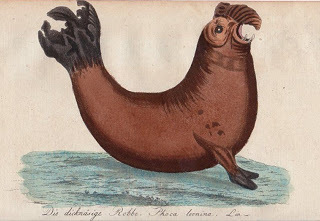 Wonderful vintage painting of an elephant seal by Johann Bechstein, 1796 (public domain)
Wonderful vintage painting of an elephant seal by Johann Bechstein, 1796 (public domain)Heuvelmans discounted the possibility that the longneck sea serpent sports anything but the shortest of tails – if, indeed, it possesses one at all. This clearly corresponds with a pinniped identity (a major problem with Oudemans's Megophias as any kind of seal was its very lengthy tail, because modern-day pinnipeds are conspicuously bereft of such a sizeable appendage). Yet he seemingly chose to ignore those eyewitness accounts that described longnecks with long tails. True, some such tails may have been artefacts, i.e. merely wakes or trails of bubbles, but others seemed genuine structures.
Heuvelmans concluded his coverage of Megalotaria by stating that apart from polar waters it exhibited a cosmopolitan distribution (an assertion drawn from the geographical distribution of eyewitness reports), generally sighted near the coast in cold temperate regions and in mid-ocean in warm temperate zones. Based upon more detailed analysis of the geographical spread of sightings plotted against the time of year when they have occurred, Heuvelmans further concluded that Megalotaria prefers spending the spring and warm season in northern cold temperate regions, migrating to the tropics to spend the end of the summer and the autumn there, before moving even further south into the southern hemisphere's temperate zone to spend the end of this latter hemisphere's summer there, thus avoiding entirely the cold extreme of the northern winter.
However, the reality of a highly mobile (and hence more readily encountered?) species of seal that is also "much bigger than the biggest pinnipeds" and occurs globally is one that I find difficult to accept. After all, the biggest pinniped currently known to exist today, the mighty southern elephant seal Mirounga leonina, already measures up to 22.5 ft long and can weigh over 10,000 lb – dimensions that are hardly inconsiderable.
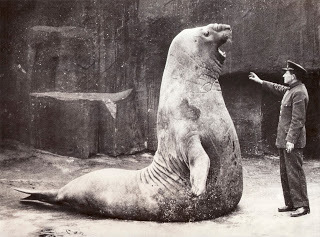 Vintage photograph from 1936 depicting Goliath the elephant seal and his keeper at Vincennes Zoo, Paris, which readily reveals the huge size of such pinnipeds (public domain)
Vintage photograph from 1936 depicting Goliath the elephant seal and his keeper at Vincennes Zoo, Paris, which readily reveals the huge size of such pinnipeds (public domain)Yet if Heuvelmans is to be believed, this latter pinniped is positively dwarfed by a truly colossal species that is three times its size, and whose long-necked morphology sets it even further apart from all other pinnipeds, but which, incredibly, is still unrepresented by a single specimen. Not even so much as a beached skull or skeleton portion appears ever to have been discovered and retrieved on any coast anywhere in the world, despite Heuvelmans's assertion that the longneck is of cosmopolitan distribution, and whereas occasional remains even of exceedingly little-known and quite possibly uncommon species of beaked whale and other very large, exclusively maritime mammals have indeed been found washed ashore.
In 2007, an extensive 117-page article written by cryptozoological enthusiast Robert Cornes that supported the possibility of the longneck sea serpent and its freshwater counterpart constituting some form of undiscovered long-necked pinniped was published in that year's CFZ Yearbook, and included a number of thought-provoking speculations. One of these was that perhaps this surreal seal does come ashore to breed (rather than doing so at sea, as proposed by Heuvelmans) but remains unseen while on land by breeding in remote, inaccessible caves. Bearing in mind that seals breeding on land is generally not only a very visual affair but also a very noisy one, it would surely require a highly secluded location indeed for Megalotaria to breed while remaining out of earshot. Another speculation concerned whether the lengthy neck may assist in thermoregulation, in a manner reminiscent of one confirmed with seal flippers – in which warm blood can be diverted into these limbs, after which they are waved in the air to assist the animal in cooling off.
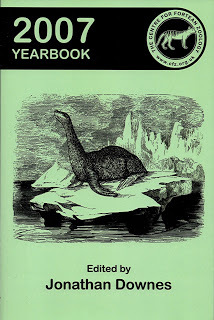 A long-necked seal on the front cover of the CFZ 2007 Yearbook, which contains Cornes's very detailed article on this hypothetical pinniped (© CFZ/Robert Cornes)
A long-necked seal on the front cover of the CFZ 2007 Yearbook, which contains Cornes's very detailed article on this hypothetical pinniped (© CFZ/Robert Cornes)Also in 2007, sea serpent researcher Bruce A. Champagne published a comprehensive article entitled 'A classification system for large, unidentified marine animals based on the examinations of reported observations' within the multi-contributor tome Elementum Bestia (edited by American cryptozoologist Craig Heinselman). Like Heuvelmans, Champagne differentiated nine different sea serpent types, but they did not all correspond with Heuvelmans's; moreover, he also subdivided some of these types to yield several subtypes.
One of Champagne's nine types was the longneck, which he then split into two subtypes, distinguished primarily via the size of the head in relation to the neck diameter. Most longneck sightings were assigned by him to the first subtype, in which the head's diameter was the same as or slightly smaller than that of the neck. In addition, and going totally against Heuvelmans's opinion, Champagne proposed that this longneck subtype sported a long tail (thereby hearkening back to Oudemans and Megophias). The second subtype, in which the head's diameter was larger than the neck's, consisted of five sightings from the North Atlantic off Great Britain and Denmark, and all five of these featured robust animals that, according to the eyewitnesses, were over 55 ftlong, and therefore much bigger than those longnecks constituting the first subtype, which did not exceed 30 ft at most.
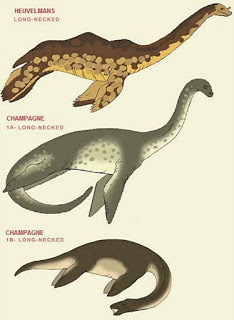 Representation of Champagne's two longneck subtypes, compared with Heuvelmans's Megalotaria longneck (© Tim Morris)
Representation of Champagne's two longneck subtypes, compared with Heuvelmans's Megalotaria longneck (© Tim Morris)To me, the longneck sea serpent is an enigma – a cryptid that I want so much to exist, as it would solve so many cryptozoological riddles – and not just marine ones either, as I'll be discussing in Part 2 of this ShukerNature blog article – but which, at least in the guise of Megalotaria as envisaged by Heuvelmans, seems beset by serious shortcomings.
This ShukerNature blog article is excerpted from my forthcoming book, Here's Nessie!: A Monstrous Compendium from Loch Ness .
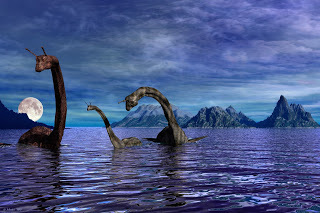 William Michael Mott's spectacular artwork featuring a trio of horned/snorkelled longnecks, which will be appearing in my Nessie book (© William Michael Mott)
William Michael Mott's spectacular artwork featuring a trio of horned/snorkelled longnecks, which will be appearing in my Nessie book (© William Michael Mott)
Published on July 27, 2015 19:54
July 22, 2015
NICK REDFERN REVIEWS DRAGONS IN ZOOLOGY, CRYPTOZOOLOGY, AND CULTURE - THANKS NICK!
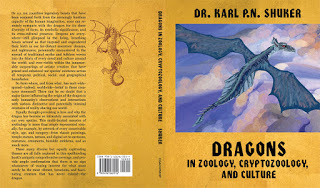
Dragons are clearly in season right now. Following hot on the heels of two excellent recent reviews of my book Dragons in Zoology, Cryptozoology, and Culture , by Richard Freeman in the CFZ's magazine Animals and Men and by Matt Salusbury in Fortean Times respectively (click here to read both reviews on ShukerNature), is a third fantastic review, this time by none other than fellow cryptozoologist, bestselling author, and - most important of all! - Black Countryman Nick Redfern.
Please click here to read Nick's review on his spectacular website Mysterious Universe.
Thanks again, Nick - bostin' review, as we Black Countrymen say!! (And for those of you who may not have any idea what I'm talking about and what or even where the Black Country is - shame on you! - click here to read Wikipedia's account of this historical region of the West Midlands in England, where Nick and I were both born, just a couple of mile or so from each other, in fact, and which has such a long, proud heritage in England's development and advancement, especially during the Industrial Revolution).
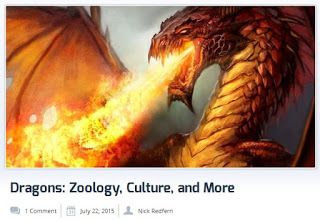 Header to Nick's review of my dragons book on Mysterious Universe ((c) Nick Redfern/Mysterious Universe)
Header to Nick's review of my dragons book on Mysterious Universe ((c) Nick Redfern/Mysterious Universe)
Published on July 22, 2015 12:38
July 18, 2015
DEBUNKING A TRIO OF QUASI-COLOURED MOCK PYTHONS
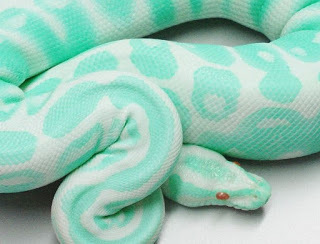 Photograph of a supposed green and white ball python, found by me on Pinterest (see below for © of original photograph)
Photograph of a supposed green and white ball python, found by me on Pinterest (see below for © of original photograph)Having a longstanding interest in animal colour morphs, I knew that something was very wrong – distinctly off-colour, in every sense – when, while browsing on the image-sharing/-hosting website Pinterest a couple of days ago in search of some unusual animal photographs to pin to my recently-created Pinterest board devoted to cryptozoology, animal mythology, and (un) natural history, I came upon the remarkable picture opening this present ShukerNature blog article. (Click here to view my Pinterest board - but you'll need to sign into Pinterest's site once you've clicked this link before it will let you see my board.)
For although I knew that a dazzling range and vast number of colour morphs have been developed for many snake species (including various pythons and boas) commonly sold in the pet trade (such selectively-bred forms being referred to as designer snakes), I felt pretty sure that these did not include a green and white variety for the African ball python Python regius (aka the royal python), regardless of what my eyes were seeing when looking at this particular photograph. (I know that a morph dubbed 'green' does exist, but in reality it is merely khaki, not grass-green like the specimen in this photo.) Anxious not to lose it, however, I swiftly pinned it to my Pinterest board, and then did what I always do as standard practice nowadays whenever confronted by a strange or unexpected animal picture – I conducted a Google image search for it online, in the hope of tracing its origin.
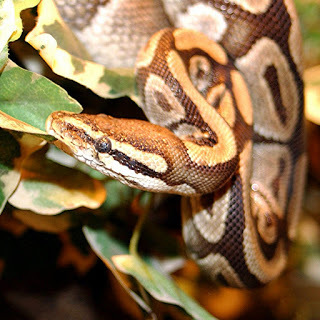 A normal, wild-type specimen of the ball python (public domain)
A normal, wild-type specimen of the ball python (public domain)But all that I could find, pages and pages of them, were links to this self-same image on dozens of other Pinterest pages as well as many pages on other image-sharing/-hosting websites too, such as Tumblr and Flickr, yet with no clues whatsoever as to where it had originated. I didn't even come upon a single comment from any of these numerous image-sharers that queried whether these pythons of a very different colour were genuine. (Then again, if it's on the internet it must be true! lol)
Something that I did find, however, was that this photo of a green-and-white ball python was not one of a kind, because during my search I discovered two equally unlikely variations upon its crazy colour scheme.
 The same photograph as the one opening this ShukerNature blog article, and again common on image-sharing/-hosting websites, but in which the green hue has been replaced by a pink hue (see below for © of original photograph)
The same photograph as the one opening this ShukerNature blog article, and again common on image-sharing/-hosting websites, but in which the green hue has been replaced by a pink hue (see below for © of original photograph)That is to say, I found some copies of exactly the same photo but in which the green hue had been replaced by pink, and some other copies in which it had been replaced by lilac – both of them once again being shared ad infinitum on Pinterest, Flickr, Tumbr, etc, but also once again with no clues as to where either of these variants had originated, and no challenges to their serpentine subjects' authenticity.
 The same photograph as the one opening this ShukerNature blog article, and again common on image-sharing/-hosting websites, but in which the green hue has been replaced by a lilac hue (see below for © of original photograph)
The same photograph as the one opening this ShukerNature blog article, and again common on image-sharing/-hosting websites, but in which the green hue has been replaced by a lilac hue (see below for © of original photograph)The fact that I had now uncovered three different colour versions of the very same photograph meant either that two of these versions were fakes, photo-manipulated by person(s) unknown from the third, or that all three were fakes, photo-manipulated from a true-to-life original version that I had yet to locate online. I favoured the latter possibility, because, as already noted, I was not aware of any comparable yet genuine green, pink, or lilac colour morphs existing for the ball python, and after checking a number of websites devoted to ball python morphs I found no evidence whatsoever that any of the three did indeed exist. Clearly, therefore, there was a fourth, original, unmodified version of the photo out there somewhere, currently unseen by me, and which would prove to be the original version – but what might the snake in it look like, what would its true colouration be?
When I had first seen the green version, it had struck me straight away that, ignoring its markings' bizarre colouration and focusing instead upon their form and paleness, the snake recalled the ball python's very abundant golden colour morph. This particular colour morph has been developed by selective captive breeding in a number of other constrictor species too, perhaps most famously in the Burmese python P. bivittatus. Golden specimens of this latter species are exceptionally popular, very highly-prized pets due to the enhancement of their already beautiful appearance by way of the huge and extremely impressive body size for which this species is renowned (and which, again, is actively selected for when captive-bred by the pet trade).
 A xanthistic Burmese python (© Dr Karl Shuker)
A xanthistic Burmese python (© Dr Karl Shuker)Genetically speaking, this golden morph is xanthistic, i.e. it occurs due to the expression of a certain specific mutant gene allele that causes a specimen possessing this allele to produce an excess of yellow pigmentation; sometimes the specimen's normal red pigment for its species is lacking and has been replaced entirely by yellow pigment. Despite this, however, in the pet trade xanthistic snake specimens are often confusingly called albinos (yet, genetically, this term should only be used to describe pure-white specimens with pink eyes, such specimens being caused by different gene alleles from those responsible for xanthism). The most sought-after xanthistic pythons of all are ones that lack both red and black pigmentation, resulting in exceptionally handsome specimens that seem almost to emit a golden glow when viewed under certain levels of illumination, and are known technically as amelanic xanthistic pythons.
Consequently, I decided to conduct another Google image search, but this time using the specific search phrase 'albino ball python' – and sure enough, after scouring through countless photos of such snakes, I finally came upon one that, except for the snake's colour in it, was identical to the green, pink, and lilac versions that I'd previously encountered online. There could be no doubt – this particular photograph of a normal, real-life golden ball python was the original that had been photo-manipulated very professionally if anonymously by agent(s) unknown. And here, as absolute proof, is that original, undoctored photograph.
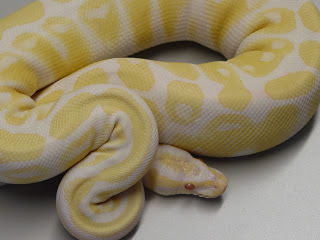 Golden (or so-called 'albino') ball python (© Nat Turner/all rights reserved – fair use only here on ShukerNature; click
here
to access Nat's webpage containing full technical details for this photograph)
Golden (or so-called 'albino') ball python (© Nat Turner/all rights reserved – fair use only here on ShukerNature; click
here
to access Nat's webpage containing full technical details for this photograph)This photograph had been snapped without flash by American photographer Nat Turner on 22 May 2004, it depicts what Nat describes as a large female specimen, and it had been posted by him onto his Flickr site, which is where I found it. Moreover, it is one of several photos by Nat that seem to depict the same specimen, and which are all contained in an online Flickr album of his entitled 'Snakes'.
The quasi-coloured mock pythons beloved and believed in by so many online image sharers were no more – a trio of counterfeit serpents duly debunked and discarded, yet another case of photo-manipulation chicanery summarily expunged from the archives of valid zoological anomalies.
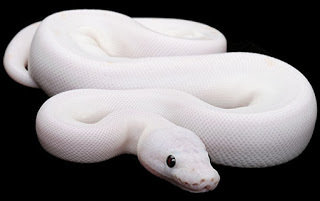 A specimen of the ball python's black-eyed leucistic ('snow') morph (© The Urban Zoo – be sure to click
here
to visit their excellent pet-store website)
A specimen of the ball python's black-eyed leucistic ('snow') morph (© The Urban Zoo – be sure to click
here
to visit their excellent pet-store website)Incidentally, another very popular python morph that is sometimes termed albino in the pet trade, but which once again is very different genetically, is the snow python. For although it does possess the albino mutant gene allele, it also possesses the axanthic mutant gene allele, whose effect is the exact opposite of the xanthic version, because it does not increase yellow pigmentation but reduces it instead. The combined effect of these two alleles' expression is an ethereal-looking snake that is pure-white all over like a bona fide albino specimen, but has blue or black eyes, instead of pink ones like an albino.
Finally: it may seem scarcely believable but it is not unknown for park rangers and others to witness occasionally the astonishing spectacle of an enormous Burmese python locked in mortal combat with a mighty American alligator in the Florida Everglades. Such titanic battles occur because this huge non-native ophidian species has successfully established breeding populations here following pet specimens having escaped and/or been deliberately released during the 20th Century. And because both are top reptilian predators, whenever they encounter one another neither one of them is willing to back down.
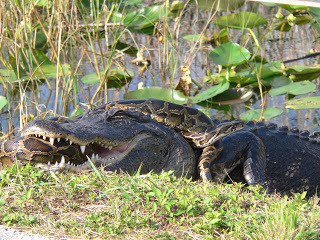 Battleof the reptilian behemoths – a wild-type naturalised ball python versus an adult American alligator (public domain)
Battleof the reptilian behemoths – a wild-type naturalised ball python versus an adult American alligator (public domain)
Published on July 18, 2015 14:17
July 17, 2015
REVIEWING DRAGONS IN ZOOLOGY, CRYPTOZOOLOGY, AND CULTURE
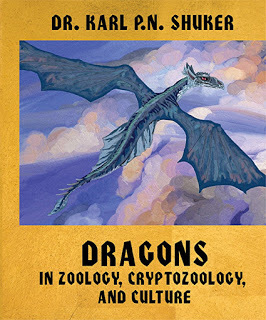 My second dragons book –
Dragons in Zoology, Cryptozoology, and Culture
, published by Coachwhip Publications (© Dr Karl Shuker/Coachwhip Publications)
My second dragons book –
Dragons in Zoology, Cryptozoology, and Culture
, published by Coachwhip Publications (© Dr Karl Shuker/Coachwhip Publications)The year 1995 saw the publication of two books of mine, one of which was Dragons: A Natural History – a lavishly-illustrated volume in which I concentrated upon providing a series of vibrant, lyrical retellings of famous and lesser-known dragon myths, legends, and folktales from around the world, arranged into chapters focusing upon different morphological and natural history categories of dragon, and interspersed throughout with smatterings of cryptozoological content and snippets of other dragon-related background information. Over the years, it was translated into over a dozen languages, has been reissued many times, and, judging from its huge sales worldwide, may well be the most successful non-fiction book on dragons ever published. So how could I follow that?
 Some of the many English and foreign-language editions of my book
Dragons: A Natural History
– From left to right, top row: English, Czech, Italian, Spanish, and Japanese; bottom row: Estonian, Hungarian, German, Dutch, and French – click image to enlarge it (© Dr Karl Shuker)
Some of the many English and foreign-language editions of my book
Dragons: A Natural History
– From left to right, top row: English, Czech, Italian, Spanish, and Japanese; bottom row: Estonian, Hungarian, German, Dutch, and French – click image to enlarge it (© Dr Karl Shuker)And yet I did want to follow it, because I'd always planned to write an extremely comprehensive review of dragons in their entirety – not just their myths, morphology, and natural history, but also providing in-depth coverages of the real-life and possible cryptozoological influences responsible for engendering dragons, and these mythical monsters' omnipresence in human culture, both ancient and modern – from religion and the mystic arts to the visual arts and literature, fashion to sport, tattoos to compute games, rock music to dream interpretation, and mush more besides.
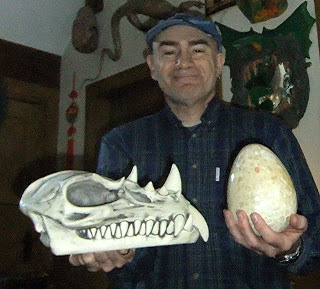 With my very own young dragon skull and dragon egg… © Dr Karl Shuker)
With my very own young dragon skull and dragon egg… © Dr Karl Shuker)After extensive research, I finally wrote my long-planned second dragons book – entitled Dragons in Zoology, Cryptozoology, and Culture – and saw it published in 2013 by Coachwhip Publications of Greenville, Ohio. It constitutes one of the most comprehensive dragon-themed factual books ever published, is sumptuously illustrated throughout in full colour, and today I was delighted to see not one but two positive, encouraging reviews of it.
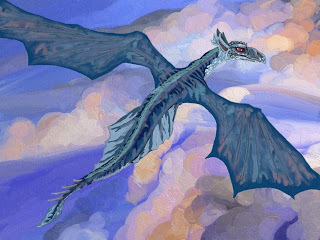 The beautiful dragon painting by the very talented cryptozoological artist Thomas Finley that appears on the front cover of my newest dragons book (© Thomas Finley)
The beautiful dragon painting by the very talented cryptozoological artist Thomas Finley that appears on the front cover of my newest dragons book (© Thomas Finley)By one of those wonderful coincidences that happen only rarely but help to restore one's belief that the world may indeed be a good place to inhabit when they do happen, today I received in the post two different magazines, only to discover that they each contained an excellent review of my newest, second dragons book. One was written by fellow dragons aficionado Richard Freeman, and appeared in #52 (February 2015) of the Centre for Fortean Zoology's magazine Animals and Men; the other was written by longstanding cryptozoogical researcher Matt Salusbury, and appeared in #330 (August 2015) of Fortean Times.
So for those of you who haven't read my new dragons book and may be interested in doing so, here are these two reviews, each one a two-pager. Please click the images to enlarge them for reading purposes.
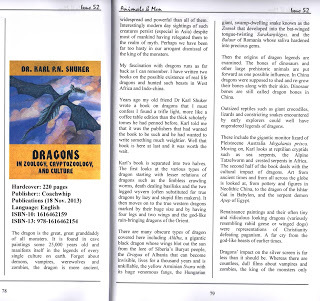
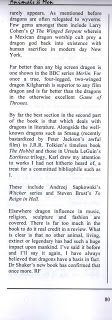 Richard Freeman's review of my book
Dragons in Zoology, Cryptozoology, and Culture
in Animals and Men (© Richard Freeman/Animals and Men)
Richard Freeman's review of my book
Dragons in Zoology, Cryptozoology, and Culture
in Animals and Men (© Richard Freeman/Animals and Men)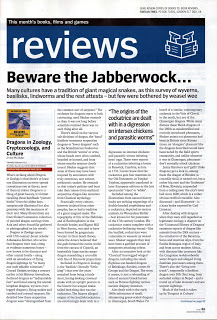
 Matt Salusbury's review of my book
Dragons in Zoology, Cryptozoology, and Culture
in Fortean Times (© Matt Salusbury/Fortean Times)
Matt Salusbury's review of my book
Dragons in Zoology, Cryptozoology, and Culture
in Fortean Times (© Matt Salusbury/Fortean Times)My sincere thanks to Rich and Matt for their reviews, which have made all of the toil researching such a vast albeit fascinating subject as dragons worthwhile.
If you'd like to read more about my new dragons book, please click here to read its own page on my website, which also includes direct links to Amazon's USA and UK sites for anyone wishing to purchase a copy. Also, please click here if you'd like to purchase a copy via its publisher, Coachwhip Publications (which is also the publisher of my definitive Encyclopaedia of New and Rediscovered Animals ). Click here and here for more information about my new dragons book as posted on ShukerNature; and click here and here to read two lengthy excerpts from it exclusively on ShukerNature.
 My two books published so far by Coachwhip Publications (© Dr Karl Shuker/Coachwhip Publications)
My two books published so far by Coachwhip Publications (© Dr Karl Shuker/Coachwhip Publications)
Published on July 17, 2015 12:33
July 13, 2015
LESSER NESSIES - SURVEYING THE 'OTHER' MONSTERS OF MAINLAND SCOTLAND'S FRESHWATER LOCHS
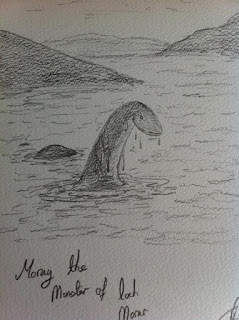 Sketch of Morag, the monster of Loch Morar, based upon eyewitness accounts (© Michael Playfair)
Sketch of Morag, the monster of Loch Morar, based upon eyewitness accounts (© Michael Playfair)Everyone has heard of Nessie, the reputed monster of Loch Ness, but fewer people realise that mystery beasts of various forms have also been reported from a sizeable number of other mainland Scottish freshwater lochs. Many of these reports were first compiled in Peter Costello's standard work In Search of Lake Monsters (1974) and later summarised in Michael Newton's very comprehensive Encyclopedia of Cryptozoology (2005), but here is a representative selection.
LOCHS ARKAIG, ASSYNT, AND FEITH AN LEÒTHAID
With a maximum depth of 359 ft and measuring 12 miles long, Loch Arkaig is situated in the Lochaber area of the Highlands. In a diary entry for 3 October 1857, English politician Lord Malmesbury recorded that his game stalker, John Stuart, had twice seen at Achnaharry the horse-like head and hindquarters of a 'lake-horse' basking at the loch's surface at sunrise when there were no ripples on the water. This loch monster has since been dubbed Archie.
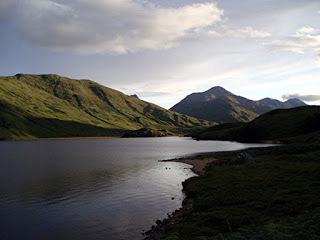 Loch Arkaig (© Angela Mudge/Creative Commons Licence)
Loch Arkaig (© Angela Mudge/Creative Commons Licence)In an article on Scottish loch monsters published during the early 1850s, Malmesbury included a claimed monster sighting from 1837 on Loch Assynt in Sutherland by two fishermen, who also saw it a second time shortly afterwards on a small island in this 6.3-mile-long loch. Very hairy, and grey in colour, the creature was compared by them to a young bull in size but with a broader back. It was about 3 ft tall, quadrupedal, with a bulldog-like head and large eyes.
Loch Feith an Leòthaid is connected to Loch Assynt, and during the 1930s an unidentified creature with a long neck and a deer-like head apparently surfaced close to the boat of Kenneth MacKenzie from Steen, gazing across this vessel's stern before disappearing again.
LOCH AWE
The third largest freshwater loch in Scotland by surface area (which is approximately 15 square miles), Loch Awe in Argyll and Bute is also this country's longest at 25 miles in total, and is reputedly home to a mysterious serpentiform monster known as the beathach mór. As far back as the 16thCentury, fishermen were claiming that this loch's waters harboured gigantic eels "as big as a horse with an incredible length" - a belief that remains prevalent here today, though no eel of such inordinate dimensions has ever been drawn forth and made available for scientific scrutiny.
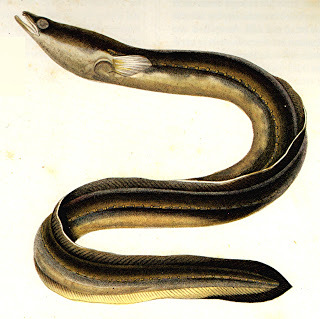 Do enormous eels inhabit the vast waters of Loch Awe? (public domain)
Do enormous eels inhabit the vast waters of Loch Awe? (public domain)LOCHS EIL AND LINHE
One of the most unusual water monsters reported from a Scottish freshwater loch is the faceless, vermiform horror encountered at Loch Eil in the western Highlands by author Denys-James Watkins-Pitchford and documented by him in 1962. Here, quoted directly from his book September Road to Caithness and the Western Sea, is his first-hand description of what he saw:
I was watching some mallard paddling about among some weedy rocks at the end of a little promontory when there appeared out of the calm water exactly opposite me a large black shiny object which I can only compare with the blunt, blind head of an enormous worm.
It was, I suppose, some 50 yards from where I was standing, and it kept appearing and disappearing, not moving along, but rolling on the surface. The water was greatly disturbed all round the object. It had a shiny wet-looking skin, but the head (if head it was) was quite unlike a seal's and had no face, or nose, no eyes. It rose quite a long way out of the water, some three feet or more, before sinking back.
The most obvious explanation for a large elongate creature in a Scottish freshwater loch is an eel; but unless the creature was inaccurately recorded by its eyewitness, an eel with no face, not even any eyes, would be a very unusual one indeed - and one that could rise 3 ft or more out of the water would be even more so (as would a worm for that matter!).
Loch Eil is linked to Loch Linhe, a sea loch on Scotland's west coast and where, during the 1890s, a still-unidentified eel-like animal of sizeable length but bearing a mane was found dead at Corpach Lock, close to Fort William at Linhe's north end. Might this have been a vagrant giant oarfish Regalecus glesne that had made its way, or (perhaps dying) had been carried by water currents, into this coastal loch from the open sea? Long-necked Nessie-type monsters have also been sighted here, during the 1940s and again during the 1960s.
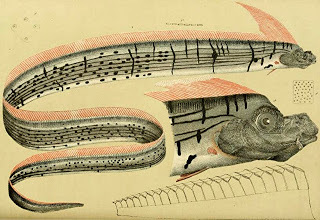 Was a giant oarfish found dead in Loch Linhe? (public domain)
Was a giant oarfish found dead in Loch Linhe? (public domain)LOCH GARTEN
Situated in the Strathspey area of Scotland's Cairngorms National Park, Loch Garten is most famous nowadays for the RSPB-coordinated success story in the breeding of wild ospreys here, but in bygone times it was famed for reputedly being home to a fearsome lake monster known as a water-bull or tarbh uisge. Resembling a hybrid of horse and bull, it sported a huge horned head, a jet-black mane, and would give vent to an extremely loud, hideous, roaring bellow.
According to local lore, a bold crofter once sought to trap this formidable creature, using as bait a young lamb attached to a very large hook, which in turn was tethered by a long sturdy rope to a huge lochside boulder weighing many tons. After rowing out to the centre of the loch and dropping the hooked lamb there, the crofter returned to shore in the hope that the water-bull would swallow the bait during the night, and thus be snared internally by the engulfed hook, after which he would haul the beast ashore. But when he checked the following morning, both the lamb and the boulder were gone. All that could be seen was a deep rut in the ground, where something with immense strength had dragged the massively heavy boulder into the loch.
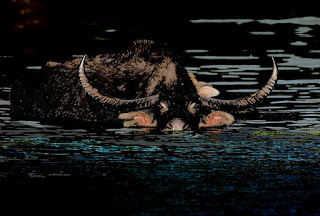 Was a water-bull lured to its death in the dark waters of Loch Garten one night by a canny crofter? (© Steve Garvie/Wikipedia – photo-manipulated by Dr Karl Shuker)
Was a water-bull lured to its death in the dark waters of Loch Garten one night by a canny crofter? (© Steve Garvie/Wikipedia – photo-manipulated by Dr Karl Shuker)As the water-bull was never seen or heard again, the inference in this tale is that once in the water, the huge boulder's weight had dragged the water-bull down to the loch bottom - where, unable to free itself from the hook that had snared it internally when it swallowed the lamb, the monster had drowned.
LOCH LOCHY
The lesser Nessie that has attracted most media attention in fairly recent times is Lizzie, the monster of 10-mile-long Loch Lochy - Scotland's third deepest loch (531 ft at its maximum depth), sited immediately below Loch Oich. With no publicised sightings for 36 years, Lizzie reclaimed the headlines in September 1996, when a 12-ft-long, dark-coloured mystery beast with a curved head and three humps reared up out of the water and began moving round in circles in full view of several staff and guests at the Corriegour Lodge Hotel, overlooking the loch. According to Aberdeen University psychology student Catriona Allen, who studied this amazing sight through binoculars: "It certainly wasn't a seal, otter, porpoise or dolphin".
In late July 1997, a six-man expedition featuring previous Loch Morar diver Cameron Turner and led by Gary Campbell, president of the Official Loch Ness Monster Fan Club, arrived to conduct a sonar sweep of the loch. Encouragingly, they achieved success on their very first day, when their equipment detected a large unidentified object swimming in the middle of the loch and estimated at 15-20 ft long - far bigger than anything known to be there. Turner came back to Lochy in September 1997, but no new evidence was obtained.
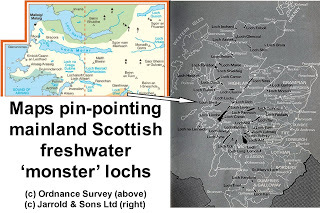 Maps pin-pointing some of mainland Scotland's 'monster' lochs – click to enlarge (© Ordnance Survey (left); © Jarrold & Sons Ltd (right))
Maps pin-pointing some of mainland Scotland's 'monster' lochs – click to enlarge (© Ordnance Survey (left); © Jarrold & Sons Ltd (right))LOCH LOMOND
By surface area, totalling 27 square miles, Loch Lomond in Scotland's West Dunbartonshire/Argyll and Bute/Stirling region, and marking the boundary between central Scotland's highlands and lowlands, is the largest stretch of inland water in the whole of the island of Great Britain. In terms of anomalous aquatic animals and other esoterica, moreover, it is also famous as the locality claimed in an atlas published in 1659 to harbour "fish without fins" and a mysterious "floating island". And in 1724, Alexander Graham of Duchray claimed that locals living nearby sometimes see the water-horse reputedly inhabiting its waters.
More recently, at Easter 1980, a Mr and Mrs Maltman and their daughter were camping near the edge of Loch Lomond at Luss when a head and slender neck rose up to a height of about 5 ft above the water surface, no more than 200 yards away, with a long curved back visible behind. This amazing spectacle lasted for 30 seconds or so, then the head and neck swiftly submerged and were not seen again. The Maltmans were so frightened that they fled, later returning only to pack their belongings before journeying back home. And in 1997, a somewhat indistinct, unidentifiable moving object was filmed in the loch by investigator Nick Taylor.
Equally unexpected but totally verified, incidentally, is the presence on Inchconnachan, one of this loch's islands, of a naturalised, thriving population of Australian red-necked wallabies Macropus rufogriseus(also known as Bennett's wallabies). They are descended from some that were introduced there during the 1940s by Lady Arran Colquhoun, and Inchconnachan is nowadays referred to colloquially as Wallaby Island.
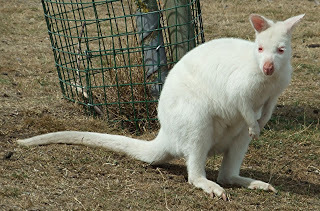 A rare albino Bennett's wallaby (© Dr Karl Shuker)
A rare albino Bennett's wallaby (© Dr Karl Shuker)LOCH MAREE
The fourth largest of Scotland's freshwater lochs by surface area, and situated in Wester Ross in the Western Highlands, Loch Maree is also referred to as Loch na Bèiste ('Loch of the Beast' in Scottish Gaelic), due to the muc-sheilch. This is a local name popularly applied to its own particular water monster and loosely translates as 'turtle-pig'. Yet despite its descriptive name, and the fact that sightings of this monster are reminiscent of Nessie reports, featuring humped backs rising above the surface and resembling capsized boats, zoologists have sought to identify it as merely a large eel.
LOCH MORAR
The most famous lesser Nessie is Morag, the monster of Loch Morar, whose history, like Nessie's, dates back many centuries, as testified by a very old Scottish song:
Morag, Harbinger of Death,Giant swimmer in deep-green Morar,The loch that has no bottom...There it is that Morag the monster lives.
Loch Morar is 11 miles long, approximately 1.5 miles wide, and with a maximum depth exceeding 1000 ft it is Britain's deepest freshwater lake. Unlike the waters of Loch Ness, however, which are extremely peaty, Morar's are very clear, enabling objects situated at quite a distance beneath the surface to be perceived with remarkable clarity - as exemplified by visitor Robert Duff's extraordinary sighting on 8 July 1969.
A joiner from Edinburgh, Duff was fishing from a boat in Meoble Bay on the loch's southern shore, where the water is no more than 16 ftdeep and very lucid, when he spotted what he described as a "monster lizard", lying motionless on the loch's white, leaf-strewn bottom, looking up at him. Duff estimated the creature to be 20 ft long, with a snake-like earless head, slit eyes, and a wide mouth. Its body was grey-brown with rough skin, and it had four limbs, with three toes visible on each front foot, plus a tail. He was so startled that he revved the boat up and made off at once. Later, however, he returned to the same spot, but the animal had gone.
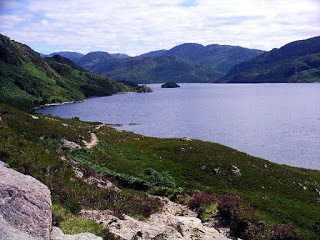 Loch Morar (© Lynne Kirton/Geograph Project/Wikipedia Creative Commons Licence)
Loch Morar (© Lynne Kirton/Geograph Project/Wikipedia Creative Commons Licence)Even more dramatic was the 5-minute confrontation experienced on 16 August 1969 by Duncan McDonell and William Simpson. At about 9.00-9.30 pm, but while still daylight, their motor boat was travelling along the loch at a speed of 6-7 knots when McDonell, at the wheel, saw a creature in the water about 20 yards behind but moving directly towards them. A few seconds later it caught up, and collided with the side of their boat, seemingly unintentionally but nonetheless with sufficient force to hurl a kettle of water off the boat's gas stove and onto the floor. McDonell attempted to fend the beast away with an oar, frightened that it may capsize the boat, but because the oar was old it snapped in half.
When Simpson saw this, he picked up his rifle, ran out of the cabin, and aimed a shot at the creature - which slowly sank away from the boat. They did not see it again, but they did not see any blood either, or any other sign to indicate that Simpson's bullet had hit it.
According to Simpson and McDonell, the portion of the creature that they had observed was 25-30 ft long, with rough, dirty-brown skin, and three humps or undulations standing about 18 in above the water surface at the highest point. The head was brown and snake-like, measuring approximately 1 ft across the top, and raised 18 in out of the water.
On 1 August 1996 came the electrifying news that Cameron Turner, a diver from Darlington, had discovered some bones from a large unidentified animal at a depth of 60 ft in Loch Morar. Could these be the mortal remains of a Morag? Sadly, no - the following day a biologist formally identified them as the bones of a deer.
Returning to the media headlines in 2013 after two decades of cryptozoological reticence, the most recent claimed encounter with Morag featured a trio of sightings in close succession. For within the space of just two days during summer 2013, holidaymakers Doug and Charlotte Christie from Brechin in Angus apparently saw the monster on three separate occasions while staying at Kisimuil bed-and-breakfast at the lochside. They saw a 20-ft-long black object in the middle of the loch, for 10 minutes on the longest occasion before it submerged again. Charlotte likened it to a whale, Doug to a submarine.
LOCH OICH
Wee Oichie or Oichy of Loch Oich, directly below Loch Ness and 4 miles long, traditionally sports a flattened head rather than the familiar equine form often noted for Nessie and various other Scottish loch monsters. Having said that, the head of the very big, black, serpentine beast that rose to the surface one summer's day in 1936 was vaguely dog-like, according to A.J. Robertson who spied it while boating at the loch's southwestern end. Certain other eyewitnesses, moreover, including a former loch keeper at Oich interviewed by investigator J.W. Herries during the 1930s, have likened Wee Oichie to a huge otter.
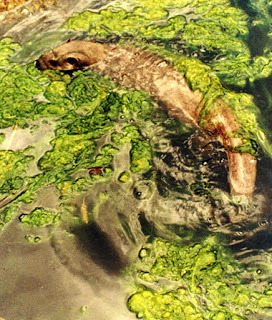 Swimming otters may sometimes be mistaken for monsters – and vice-versa? (© Dr Karl Shuker)
Swimming otters may sometimes be mistaken for monsters – and vice-versa? (© Dr Karl Shuker)As a river connects Loch Oich to Loch Ness, some researchers have speculated that perhaps Wee Oichie and Nessie are one and the same, merely swimming back and forth from one loch to another via this interconnecting river. Indeed, during the mid-1930s, Herries interviewed three eyewitnesses who claimed to have actually observed such an animal journeying via this means from Ness to Oich.
The most recent Oichy sighting currently documented occurred on 22 August 1998, when two Lochaber locals who wish to remain anonymous saw a large dark-coloured hump, rough but symmetrical in shape, break the surface a few hundred yards east of the Well of the Heads and about 22 yards from the shore as they were driving along the road next to the loch. Interestingly, they could see underneath the hump, thereby indicating that the creature was coiled and elongate. The two eyewitnesses got out of the car and ran onto the beach, armed with cameras, but the hump had already gone back down. Readily discounting identities such as swimming sheep, a line of otters, a seal, deer, and other commonly-posited candidates, they speculated that it might have been an eel, but with what they estimated to be a diameter of 18 in, if so it would have been one of truly prodigious proportions.
LOCH QUOICH
Situated west of Garry roughly 25 miles northwest of Fort William in Lochaber, Highlands, Loch Quoich is 9 miles long, with a maximum depth of 281 ft, and is supposedly home to a horse-headed but markedly serpentiform water monster. During the early 1930s, one such creature was even allegedly witnessed on land, when an unnamed lord, fishing on the loch's shores, spied it lying on a stony beach near to the water. It was also seen by the two fishing guides accompanying him, but he swore them to secrecy, afraid that the locals would consider all three of them inebriated, so their accounts remained unreleased for many years.
A collection of monster reports from Loch Quoich and other Scottish freshwater lochs was compiled by Father Henry Cyril Dieckhoff, from the Benedictine Abbey at Fort Augustus. Sadly, however, he died in 1970 before completing a book that he had been preparing, and which would have contained all of these reports.
LOCH SHIEL
Loch Morar is a famously remote lake, much of which can be reached only by boat, but this is also true of Loch Shiel - Scotland's fifth largest loch, with a length of 17 miles, a width ranging from 100 yards to a mile, and a maximum depth of 420 ft. Its own resident monster is known as Seileag.
 A mesmerisingly beautiful image of Loch Shiel (© Gil Cavalcanti/Wikipedia Creative Commons Licence)
A mesmerisingly beautiful image of Loch Shiel (© Gil Cavalcanti/Wikipedia Creative Commons Licence)Seileag's most diligent investigator was the afore-mentioned Father Dieckhoff, who collected many reports. One of these, dating from 1905, featured Ewan MacIntosh, two young boys, and an old man called Ian Crookback, all of whom observed three humps above the water surface with the aid of a telescope while travelling across the loch opposite Gasgan aboard the little mail steamer Clan Ranald.
A massive creature with a broad head, wide mouth, long thick neck, and seven "sails" (humps) on its back was viewed through a telescope by Ronald MacLeod as it emerged from the water at Sandy Point oneafternoon in 1926. Indeed, it was claimed by MacLeod to be bigger than the Clan Ranald!
LOCH TAY
Scotland's sixth largest loch by area and over 490 ft deep at its greatest depth, Loch Tay is situated in Perthshire, is approximately 14.5 miles long and typically 1.0-1.5 miles wide. Cryptozoologically speaking, however, the most notable mystery beast from this vicinity was not reported in the loch itself but from the nearby Firth of Tay, during the late evening of 30 September 1965. Moreover, it was actually seen on land, and therefore in full – a rare event indeed.
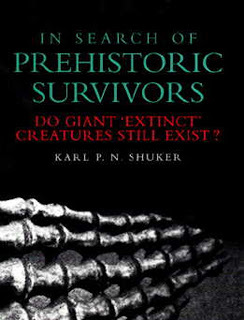
Here is my documentation of that very remarkable incident, from my book In Search of Prehistoric Survivors (1995):
[It] was brought to cryptozoological attention by veteran monster hunter F.W. Holiday. It was 11.30 pm, and Maureen Ford (wife of amateur flyweight boxer David Ford) was driving with some friends along the A85 by car towards Perth, in northeastern Scotland. Close to Perth, Ford suddenly spied an extraordinary creature by the roadside, only a few yards from the banks of the River Tay, which enters nearby into the Firth of Tay - an inlet of the North Sea. She described it as: "...a long grey shape. It had no legs but I'm sure I saw long pointed ears."
Less than 2 hours later, it was seen again - but this time on the opposite side of the road, to where it had evidently crossed during the intervening period. At 1 am, Robert Swankie was driving along the A85 away from Perthtowards Dundee, when his headlights revealed an amazing sight. As he later revealed in a Scottish Daily Express report (5 October 1965):
"The head was more than two feet long. It seemed to have pointed ears. The body, which was about 20 feet long, was humped like a giant caterpillar. It was moving very slowly and made a noise like someone dragging a heavy weight through the grass."
Swankie slowed down, and opened his window, but he could see another car not far behind, so he decided not to stop, and continued his journey. His testimony, and also that of Ford, were taped by an enthusiastic investigator, Miss Russell-Fergusson of Clarach Recordings, Oban, and the police were also informed. In the Express report, one of their spokesmen commented that in the dark the headlights of a car could play tricks when they strike walls and trees - but as Holidaysensibly pointed out, if Swankie's sighting had merely been an optical illusion, why didn't he see monsters throughout his road journey? And how can an exclusively visual deception create a dragging sound?
Far more reasonable, surely, is the scenario of a reclusive sea creature emerging under the cover of darkness from the Firth of Tay, possibly via the River Tay itself, and, by sheer chance, being seen by two night-travelling eyewitnesses during its brief overland foray.
A popular cryptozoological identity for highly elongate water monsters is an evolved, modern-day species of zeuglodont whale, possessing a more flexible vertebral column than that of fossil forms and therefore capable of performing the vertical undulations often reported for serpentiform aquatic cryptids. Might this be what emerged from the Firth of Tay 50 years ago?
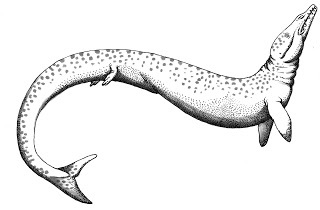 Restoration of a zeuglodont, revealing its elongate body shape (© Tim Morris)
Restoration of a zeuglodont, revealing its elongate body shape (© Tim Morris)LOCH TREIG
A reservoir since 1929, the ominously-named Loch Treig (Scottish Gaelic for 'Lake of Death') is 5.6 miles long, and is located in a steep-sided glen just over 12 miles east of Fort William in Lochaber, Highlands. According to local medieval folklore, it was home to ferocious water-horses, but mystery beasts have also been reported here in modern times. Indeed, in 1933, during the creation of the extensive hydroelectric scheme now present in this area encompassing Treig, B.N. Peach, an engineer in charge of that scheme, stated that some of the divers working on the project had quit the job or had asked to be moved to other jobs because they claimed that there were monsters in this loch's depths.
LOCH WATTEN
Last – and definitely least – is Wattie, the infamous monster of Loch Watten, infamous inasmuch as its history owes precious little to cryptozoology, and even less to reality, as I discovered when conducting the only detailed investigation ever undertaken into this extraordinary case. All is revealed elsewhere on ShukerNature – click here to read my full exposée.
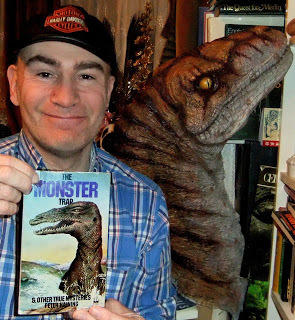 Holding my copy of The Monster Trap– Peter Haining's collection of supposedly true mysteries containing his account of the Loch Watten monster that inspired my extensive investigation of this exceedingly dubious cryptid (© Dr Karl Shuker)
Holding my copy of The Monster Trap– Peter Haining's collection of supposedly true mysteries containing his account of the Loch Watten monster that inspired my extensive investigation of this exceedingly dubious cryptid (© Dr Karl Shuker)As with the Nessie saga, many sober sightings have been reported at these Scottish lochs that do appear to feature something more than misidentified otters, seals, sturgeons, birds, boats, algal mats, and suchlike - but what? All of the familiar cryptozoological Nessie contenders have been offered - a surviving plesiosaur, an undescribed species of long-necked seal, an elusive modern-day version of the officially long-extinct elongate zeuglodont whales, a giant form of eel - but with no physical evidence to examine, no firm taxonomic identification can be offered.
If such reports as those documented here are indeed genuine, however, it seems likely that the species responsible can actively migrate overland, or via connecting rivers, from one loch to another (eels readily come to mind here) - thus explaining sightings in bodies of water that are too small or insufficiently stocked with fish and other potential prey to sustain a permanent, viable population.
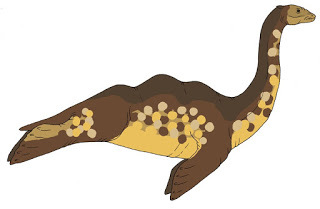 Reconstruction of the possible morphology of the long-necked (aka longneck) category of water monster, represented by both marine and freshwater versions (© Tim Morris)
Reconstruction of the possible morphology of the long-necked (aka longneck) category of water monster, represented by both marine and freshwater versions (© Tim Morris)They do say that it takes all sorts to make a world, and certainly, from traditional water-horses, water-bulls, and turtle-pigs to modern-day long-necked, serpentiform, and even vermiform aquatic cryptids, this maxim is also clearly applicable to the cryptozoological world, at least as far as the multifarious monsters reported from mainland Scotland's freshwater lochs are concerned.
 Beautiful vintage picture postcard depicting Loch Awe (public domain)
Beautiful vintage picture postcard depicting Loch Awe (public domain)This ShukerNature blog article is excerpted from my forthcoming book Here's Nessie! - A Monstrous Compendium From Loch Ness , and was inspired by a much shorter account that originally appeared in my book Mysteries of Planet Earth .
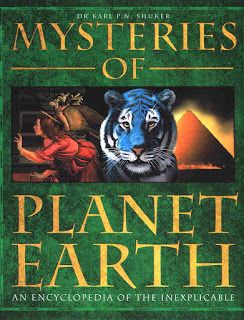
Published on July 13, 2015 08:27
LESSER NESSIES - REVIEWING THE 'OTHER' MONSTERS OF MAINLAND SCOTLAND'S FRESHWATER LOCHS
 Sketch of Morag, the monster of Loch Morar, based upon eyewitness accounts (© Michael Playfair)
Sketch of Morag, the monster of Loch Morar, based upon eyewitness accounts (© Michael Playfair)Everyone has heard of Nessie, the reputed monster of Loch Ness, but fewer people realise that mystery beasts of various forms have also been reported from a sizeable number of other mainland Scottish freshwater lochs. Many of these reports were first compiled in Peter Costello's standard work In Search of Lake Monsters (1974) and later summarised in Michael Newton's very comprehensive Encyclopedia of Cryptozoology (2005), but here is a representative selection.
LOCHS ARKAIG, ASSYNT, AND FEITH AN LEÒTHAID
With a maximum depth of 359 ft and measuring 12 miles long, Loch Arkaig is situated in the Lochaber area of the Highlands. In a diary entry for 3 October 1857, English politician Lord Malmesbury recorded that his game stalker, John Stuart, had twice seen at Achnaharry the horse-like head and hindquarters of a 'lake-horse' basking at the loch's surface at sunrise when there were no ripples on the water. This loch monster has since been dubbed Archie.
 Loch Arkaig (© Angela Mudge/Creative Commons Licence)
Loch Arkaig (© Angela Mudge/Creative Commons Licence)In an article on Scottish loch monsters published during the early 1850s, Malmesbury included a claimed monster sighting from 1837 on Loch Assynt in Sutherland by two fishermen, who also saw it a second time shortly afterwards on a small island in this 6.3-mile-long loch. Very hairy, and grey in colour, the creature was compared by them to a young bull in size but with a broader back. It was about 3 ft tall, quadrupedal, with a bulldog-like head and large eyes.
Loch Feith an Leòthaid is connected to Loch Assynt, and during the 1930s an unidentified creature with a long neck and a deer-like head apparently surfaced close to the boat of Kenneth MacKenzie from Steen, gazing across this vessel's stern before disappearing again.
LOCH AWE
The third largest freshwater loch in Scotland by surface area (which is approximately 15 square miles), Loch Awe in Argyll and Bute is also this country's longest at 25 miles in total, and is reputedly home to a mysterious serpentiform monster known as the beathach mór. As far back as the 16thCentury, fishermen were claiming that this loch's waters harboured gigantic eels "as big as a horse with an incredible length" - a belief that remains prevalent here today, though no eel of such inordinate dimensions has ever been drawn forth and made available for scientific scrutiny.
 Do enormous eels inhabit the vast waters of Loch Awe? (public domain)
Do enormous eels inhabit the vast waters of Loch Awe? (public domain)LOCHS EIL AND LINHE
One of the most unusual water monsters reported from a Scottish freshwater loch is the faceless, vermiform horror encountered at Loch Eil in the western Highlands by author Denys-James Watkins-Pitchford and documented by him in 1962. Here, quoted directly from his book September Road to Caithness and the Western Sea, is his first-hand description of what he saw:
I was watching some mallard paddling about among some weedy rocks at the end of a little promontory when there appeared out of the calm water exactly opposite me a large black shiny object which I can only compare with the blunt, blind head of an enormous worm.
It was, I suppose, some 50 yards from where I was standing, and it kept appearing and disappearing, not moving along, but rolling on the surface. The water was greatly disturbed all round the object. It had a shiny wet-looking skin, but the head (if head it was) was quite unlike a seal's and had no face, or nose, no eyes. It rose quite a long way out of the water, some three feet or more, before sinking back.
The most obvious explanation for a large elongate creature in a Scottish freshwater loch is an eel; but unless the creature was inaccurately recorded by its eyewitness, an eel with no face, not even any eyes, would be a very unusual one indeed - and one that could rise 3 ft or more out of the water would be even more so (as would a worm for that matter!).
Loch Eil is linked to Loch Linhe, a sea loch on Scotland's west coast and where, during the 1890s, a still-unidentified eel-like animal of sizeable length but bearing a mane was found dead at Corpach Lock, close to Fort William at Linhe's north end. Might this have been a vagrant giant oarfish Regalecus glesne that had made its way, or (perhaps dying) had been carried by water currents, into this coastal loch from the open sea? Long-necked Nessie-type monsters have also been sighted here, during the 1940s and again during the 1960s.
 Was a giant oarfish found dead in Loch Linhe? (public domain)
Was a giant oarfish found dead in Loch Linhe? (public domain)LOCH GARTEN
Situated in the Strathspey area of Scotland's Cairngorms National Park, Loch Garten is most famous nowadays for the RSPB-coordinated success story in the breeding of wild ospreys here, but in bygone times it was famed for reputedly being home to a fearsome lake monster known as a water-bull or tarbh uisge. Resembling a hybrid of horse and bull, it sported a huge horned head, a jet-black mane, and would give vent to an extremely loud, hideous, roaring bellow.
According to local lore, a bold crofter once sought to trap this formidable creature, using as bait a young lamb attached to a very large hook, which in turn was tethered by a long sturdy rope to a huge lochside boulder weighing many tons. After rowing out to the centre of the loch and dropping the hooked lamb there, the crofter returned to shore in the hope that the water-bull would swallow the bait during the night, and thus be snared internally by the engulfed hook, after which he would haul the beast ashore. But when he checked the following morning, both the lamb and the boulder were gone. All that could be seen was a deep rut in the ground, where something with immense strength had dragged the massively heavy boulder into the loch.
 Was a water-bull lured to its death in the dark waters of Loch Garten one night by a canny crofter? (© Steve Garvie/Wikipedia – photo-manipulated by Dr Karl Shuker)
Was a water-bull lured to its death in the dark waters of Loch Garten one night by a canny crofter? (© Steve Garvie/Wikipedia – photo-manipulated by Dr Karl Shuker)As the water-bull was never seen or heard again, the inference in this tale is that once in the water, the huge boulder's weight had dragged the water-bull down to the loch bottom - where, unable to free itself from the hook that had snared it internally when it swallowed the lamb, the monster had drowned.
LOCH LOCHY
The lesser Nessie that has attracted most media attention in fairly recent times is Lizzie, the monster of 10-mile-long Loch Lochy - Scotland's third deepest loch (531 ft at its maximum depth), sited immediately below Loch Oich. With no publicised sightings for 36 years, Lizzie reclaimed the headlines in September 1996, when a 12-ft-long, dark-coloured mystery beast with a curved head and three humps reared up out of the water and began moving round in circles in full view of several staff and guests at the Corriegour Lodge Hotel, overlooking the loch. According to Aberdeen University psychology student Catriona Allen, who studied this amazing sight through binoculars: "It certainly wasn't a seal, otter, porpoise or dolphin".
In late July 1997, a six-man expedition featuring previous Loch Morar diver Cameron Turner and led by Gary Campbell, president of the Official Loch Ness Monster Fan Club, arrived to conduct a sonar sweep of the loch. Encouragingly, they achieved success on their very first day, when their equipment detected a large unidentified object swimming in the middle of the loch and estimated at 15-20 ft long - far bigger than anything known to be there. Turner came back to Lochy in September 1997, but no new evidence was obtained.
 Maps pin-pointing some of mainland Scotland's 'monster' lochs – click to enlarge (© Ordnance Survey (left); © Jarrold & Sons Ltd (right))
Maps pin-pointing some of mainland Scotland's 'monster' lochs – click to enlarge (© Ordnance Survey (left); © Jarrold & Sons Ltd (right))LOCH LOMOND
By surface area, totalling 27 square miles, Loch Lomond in Scotland's West Dunbartonshire/Argyll and Bute/Stirling region, and marking the boundary between central Scotland's highlands and lowlands, is the largest stretch of inland water in the whole of the island of Great Britain. In terms of anomalous aquatic animals and other esoterica, moreover, it is also famous as the locality claimed in an atlas published in 1659 to harbour "fish without fins" and a mysterious "floating island". And in 1724, Alexander Graham of Duchray claimed that locals living nearby sometimes see the water-horse reputedly inhabiting its waters.
More recently, at Easter 1980, a Mr and Mrs Maltman and their daughter were camping near the edge of Loch Lomond at Luss when a head and slender neck rose up to a height of about 5 ft above the water surface, no more than 200 yards away, with a long curved back visible behind. This amazing spectacle lasted for 30 seconds or so, then the head and neck swiftly submerged and were not seen again. The Maltmans were so frightened that they fled, later returning only to pack their belongings before journeying back home. And in 1997, a somewhat indistinct, unidentifiable moving object was filmed in the loch by investigator Nick Taylor.
Equally unexpected but totally verified, incidentally, is the presence on Inchconnachan, one of this loch's islands, of a naturalised, thriving population of Australian red-necked wallabies Macropus rufogriseus(also known as Bennett's wallabies). They are descended from some that were introduced there during the 1940s by Lady Arran Colquhoun, and Inchconnachan is nowadays referred to colloquially as Wallaby Island.
 A rare albino Bennett's wallaby (© Dr Karl Shuker)
A rare albino Bennett's wallaby (© Dr Karl Shuker)LOCH MAREE
The fourth largest of Scotland's freshwater lochs by surface area, and situated in Wester Ross in the Western Highlands, Loch Maree is also referred to as Loch na Bèiste ('Loch of the Beast' in Scottish Gaelic), due to the muc-sheilch. This is a local name popularly applied to its own particular water monster and loosely translates as 'turtle-pig'. Yet despite its descriptive name, and the fact that sightings of this monster are reminiscent of Nessie reports, featuring humped backs rising above the surface and resembling capsized boats, zoologists have sought to identify it as merely a large eel.
LOCH MORAR
The most famous lesser Nessie is Morag, the monster of Loch Morar, whose history, like Nessie's, dates back many centuries, as testified by a very old Scottish song:
Morag, Harbinger of Death,Giant swimmer in deep-green Morar,The loch that has no bottom...There it is that Morag the monster lives.
Loch Morar is 11 miles long, approximately 1.5 miles wide, and with a maximum depth exceeding 1000 ft it is Britain's deepest freshwater lake. Unlike the waters of Loch Ness, however, which are extremely peaty, Morar's are very clear, enabling objects situated at quite a distance beneath the surface to be perceived with remarkable clarity - as exemplified by visitor Robert Duff's extraordinary sighting on 8 July 1969.
A joiner from Edinburgh, Duff was fishing from a boat in Meoble Bay on the loch's southern shore, where the water is no more than 16 ftdeep and very lucid, when he spotted what he described as a "monster lizard", lying motionless on the loch's white, leaf-strewn bottom, looking up at him. Duff estimated the creature to be 20 ft long, with a snake-like earless head, slit eyes, and a wide mouth. Its body was grey-brown with rough skin, and it had four limbs, with three toes visible on each front foot, plus a tail. He was so startled that he revved the boat up and made off at once. Later, however, he returned to the same spot, but the animal had gone.
 Loch Morar (© Lynne Kirton/Geograph Project/Wikipedia Creative Commons Licence)
Loch Morar (© Lynne Kirton/Geograph Project/Wikipedia Creative Commons Licence)Even more dramatic was the 5-minute confrontation experienced on 16 August 1969 by Duncan McDonell and William Simpson. At about 9.00-9.30 pm, but while still daylight, their motor boat was travelling along the loch at a speed of 6-7 knots when McDonell, at the wheel, saw a creature in the water about 20 yards behind but moving directly towards them. A few seconds later it caught up, and collided with the side of their boat, seemingly unintentionally but nonetheless with sufficient force to hurl a kettle of water off the boat's gas stove and onto the floor. McDonell attempted to fend the beast away with an oar, frightened that it may capsize the boat, but because the oar was old it snapped in half.
When Simpson saw this, he picked up his rifle, ran out of the cabin, and aimed a shot at the creature - which slowly sank away from the boat. They did not see it again, but they did not see any blood either, or any other sign to indicate that Simpson's bullet had hit it.
According to Simpson and McDonell, the portion of the creature that they had observed was 25-30 ft long, with rough, dirty-brown skin, and three humps or undulations standing about 18 in above the water surface at the highest point. The head was brown and snake-like, measuring approximately 1 ft across the top, and raised 18 in out of the water.
On 1 August 1996 came the electrifying news that Cameron Turner, a diver from Darlington, had discovered some bones from a large unidentified animal at a depth of 60 ft in Loch Morar. Could these be the mortal remains of a Morag? Sadly, no - the following day a biologist formally identified them as the bones of a deer.
Returning to the media headlines in 2013 after two decades of cryptozoological reticence, the most recent claimed encounter with Morag featured a trio of sightings in close succession. For within the space of just two days during summer 2013, holidaymakers Doug and Charlotte Christie from Brechin in Angus apparently saw the monster on three separate occasions while staying at Kisimuil bed-and-breakfast at the lochside. They saw a 20-ft-long black object in the middle of the loch, for 10 minutes on the longest occasion before it submerged again. Charlotte likened it to a whale, Doug to a submarine.
LOCH OICH
Wee Oichie or Oichy of Loch Oich, directly below Loch Ness and 4 miles long, traditionally sports a flattened head rather than the familiar equine form often noted for Nessie and various other Scottish loch monsters. Having said that, the head of the very big, black, serpentine beast that rose to the surface one summer's day in 1936 was vaguely dog-like, according to A.J. Robertson who spied it while boating at the loch's southwestern end. Certain other eyewitnesses, moreover, including a former loch keeper at Oich interviewed by investigator J.W. Herries during the 1930s, have likened Wee Oichie to a huge otter.
 Swimming otters may sometimes be mistaken for monsters – and vice-versa? (© Dr Karl Shuker)
Swimming otters may sometimes be mistaken for monsters – and vice-versa? (© Dr Karl Shuker)As a river connects Loch Oich to Loch Ness, some researchers have speculated that perhaps Wee Oichie and Nessie are one and the same, merely swimming back and forth from one loch to another via this interconnecting river. Indeed, during the mid-1930s, Herries interviewed three eyewitnesses who claimed to have actually observed such an animal journeying via this means from Ness to Oich.
The most recent Oichy sighting currently documented occurred on 22 August 1998, when two Lochaber locals who wish to remain anonymous saw a large dark-coloured hump, rough but symmetrical in shape, break the surface a few hundred yards east of the Well of the Heads and about 22 yards from the shore as they were driving along the road next to the loch. Interestingly, they could see underneath the hump, thereby indicating that the creature was coiled and elongate. The two eyewitnesses got out of the car and ran onto the beach, armed with cameras, but the hump had already gone back down. Readily discounting identities such as swimming sheep, a line of otters, a seal, deer, and other commonly-posited candidates, they speculated that it might have been an eel, but with what they estimated to be a diameter of 18 in, if so it would have been one of truly prodigious proportions.
LOCH QUOICH
Situated west of Garry roughly 25 miles northwest of Fort William in Lochaber, Highlands, Loch Quoich is 9 miles long, with a maximum depth of 281 ft, and is supposedly home to a horse-headed but markedly serpentiform water monster. During the early 1930s, one such creature was even allegedly witnessed on land, when an unnamed lord, fishing on the loch's shores, spied it lying on a stony beach near to the water. It was also seen by the two fishing guides accompanying him, but he swore them to secrecy, afraid that the locals would consider all three of them inebriated, so their accounts remained unreleased for many years.
A collection of monster reports from Loch Quoich and other Scottish freshwater lochs was compiled by Father Henry Cyril Dieckhoff, from the Benedictine Abbey at Fort Augustus. Sadly, however, he died in 1970 before completing a book that he had been preparing, and which would have contained all of these reports.
LOCH SHIEL
Loch Morar is a famously remote lake, much of which can be reached only by boat, but this is also true of Loch Shiel - Scotland's fifth largest loch, with a length of 17 miles, a width ranging from 100 yards to a mile, and a maximum depth of 420 ft. Its own resident monster is known as Seileag.
 A mesmerisingly beautiful image of Loch Shiel (© Gil Cavalcanti/Wikipedia Creative Commons Licence)
A mesmerisingly beautiful image of Loch Shiel (© Gil Cavalcanti/Wikipedia Creative Commons Licence)Seileag's most diligent investigator was the afore-mentioned Father Dieckhoff, who collected many reports. One of these, dating from 1905, featured Ewan MacIntosh, two young boys, and an old man called Ian Crookback, all of whom observed three humps above the water surface with the aid of a telescope while travelling across the loch opposite Gasgan aboard the little mail steamer Clan Ranald.
A massive creature with a broad head, wide mouth, long thick neck, and seven "sails" (humps) on its back was viewed through a telescope by Ronald MacLeod as it emerged from the water at Sandy Point oneafternoon in 1926. Indeed, it was claimed by MacLeod to be bigger than the Clan Ranald!
LOCH TAY
Scotland's sixth largest loch by area and over 490 ft deep at its greatest depth, Loch Tay is situated in Perthshire, is approximately 14.5 miles long and typically 1.0-1.5 miles wide. Cryptozoologically speaking, however, the most notable mystery beast from this vicinity was not reported in the loch itself but from the nearby Firth of Tay, during the late evening of 30 September 1965. Moreover, it was actually seen on land, and therefore in full – a rare event indeed.

Here is my documentation of that very remarkable incident, from my book In Search of Prehistoric Survivors (1995):
[It] was brought to cryptozoological attention by veteran monster hunter F.W. Holiday. It was 11.30 pm, and Maureen Ford (wife of amateur flyweight boxer David Ford) was driving with some friends along the A85 by car towards Perth, in northeastern Scotland. Close to Perth, Ford suddenly spied an extraordinary creature by the roadside, only a few yards from the banks of the River Tay, which enters nearby into the Firth of Tay - an inlet of the North Sea. She described it as: "...a long grey shape. It had no legs but I'm sure I saw long pointed ears."
Less than 2 hours later, it was seen again - but this time on the opposite side of the road, to where it had evidently crossed during the intervening period. At 1 am, Robert Swankie was driving along the A85 away from Perthtowards Dundee, when his headlights revealed an amazing sight. As he later revealed in a Scottish Daily Express report (5 October 1965):
"The head was more than two feet long. It seemed to have pointed ears. The body, which was about 20 feet long, was humped like a giant caterpillar. It was moving very slowly and made a noise like someone dragging a heavy weight through the grass."
Swankie slowed down, and opened his window, but he could see another car not far behind, so he decided not to stop, and continued his journey. His testimony, and also that of Ford, were taped by an enthusiastic investigator, Miss Russell-Fergusson of Clarach Recordings, Oban, and the police were also informed. In the Express report, one of their spokesmen commented that in the dark the headlights of a car could play tricks when they strike walls and trees - but as Holidaysensibly pointed out, if Swankie's sighting had merely been an optical illusion, why didn't he see monsters throughout his road journey? And how can an exclusively visual deception create a dragging sound?
Far more reasonable, surely, is the scenario of a reclusive sea creature emerging under the cover of darkness from the Firth of Tay, possibly via the River Tay itself, and, by sheer chance, being seen by two night-travelling eyewitnesses during its brief overland foray.
A popular cryptozoological identity for highly elongate water monsters is an evolved, modern-day species of zeuglodont whale, possessing a more flexible vertebral column than that of fossil forms and therefore capable of performing the vertical undulations often reported for serpentiform aquatic cryptids. Might this be what emerged from the Firth of Tay 50 years ago?
 Restoration of a zeuglodont, revealing its elongate body shape (© Tim Morris)
Restoration of a zeuglodont, revealing its elongate body shape (© Tim Morris)LOCH TREIG
A reservoir since 1929, the ominously-named Loch Treig (Scottish Gaelic for 'Lake of Death') is 5.6 miles long, and is located in a steep-sided glen just over 12 miles east of Fort William in Lochaber, Highlands. According to local medieval folklore, it was home to ferocious water-horses, but mystery beasts have also been reported here in modern times. Indeed, in 1933, during the creation of the extensive hydroelectric scheme now present in this area encompassing Treig, B.N. Peach, an engineer in charge of that scheme, stated that some of the divers working on the project had quit the job or had asked to be moved to other jobs because they claimed that there were monsters in this loch's depths.
LOCH WATTEN
Last – and definitely least – is Wattie, the infamous monster of Loch Watten, infamous inasmuch as its history owes precious little to cryptozoology, and even less to reality, as I discovered when conducting the only detailed investigation ever undertaken into this extraordinary case. All is revealed elsewhere on ShukerNature – click here to read my full exposée.
 Holding my copy of The Monster Trap– Peter Haining's collection of supposedly true mysteries containing his account of the Loch Watten monster that inspired my extensive investigation of this exceedingly dubious cryptid (© Dr Karl Shuker)
Holding my copy of The Monster Trap– Peter Haining's collection of supposedly true mysteries containing his account of the Loch Watten monster that inspired my extensive investigation of this exceedingly dubious cryptid (© Dr Karl Shuker)As with the Nessie saga, many sober sightings have been reported at these Scottish lochs that do appear to feature something more than misidentified otters, seals, sturgeons, birds, boats, algal mats, and suchlike - but what? All of the familiar cryptozoological Nessie contenders have been offered - a surviving plesiosaur, an undescribed species of long-necked seal, an elusive modern-day version of the officially long-extinct elongate zeuglodont whales, a giant form of eel - but with no physical evidence to examine, no firm taxonomic identification can be offered.
If such reports as those documented here are indeed genuine, however, it seems likely that the species responsible can actively migrate overland, or via connecting rivers, from one loch to another (eels readily come to mind here) - thus explaining sightings in bodies of water that are too small or insufficiently stocked with fish and other potential prey to sustain a permanent, viable population.
 Reconstruction of the possible morphology of the long-necked (aka longneck) category of water monster, represented by both marine and freshwater versions (© Tim Morris)
Reconstruction of the possible morphology of the long-necked (aka longneck) category of water monster, represented by both marine and freshwater versions (© Tim Morris)They do say that it takes all sorts to make a world, and certainly, from traditional water-horses, water-bulls, and turtle-pigs to modern-day long-necked, serpentiform, and even vermiform aquatic cryptids, this maxim is also clearly applicable to the cryptozoological world, at least as far as the multifarious monsters reported from mainland Scotland's freshwater lochs are concerned.
 Beautiful vintage picture postcard depicting Loch Awe (public domain)
Beautiful vintage picture postcard depicting Loch Awe (public domain)This ShukerNature blog article is excerpted from my forthcoming book Here's Nessie! - A Monstrous Compendium From Loch Ness , and was inspired by a much shorter account that originally appeared in my book Mysteries of Planet Earth .

Published on July 13, 2015 08:27
July 9, 2015
COURTING THE COBRA KING - DANCING WITH DEATH, AND SPITTING IN THE FACE OF DANGER!
 Burmese snake charmer Saya Hnin-Mahla kissing one of her king cobra co-performers (public domain)
Burmese snake charmer Saya Hnin-Mahla kissing one of her king cobra co-performers (public domain)Since time immemorial, humans have been irresistibly fascinated by snakes - but most especially by cobras, nurturing an innate, inexplicable desire for close interaction, and even intimacy, with these large, highly venomous, and ostensibly imperious entities. This arcane aspiration has attained expression by all manner of different means - including fear-infiltrated veneration and handling by acolytes of Indian snake cults that perceived cobras as reincarnations of bygone leaders and referred to them as nagas; the fragile balance of respect and control achieved in authentic cobra charming; and even highly-emotive displays of devoted, unreserved love for the regal reptiles that are fervently believed by many to bestow blessings upon their homes and lives.
Yet for many Westerners, cobra cults and other manifestations of humankind's mystical inter-relationship with these serpents are totally alien concepts - exhibiting facets of human and reptilian behaviour that seemingly transcend traditional explanation or rationalisation. And none is more dramatic, or potentially deadly, than the cult of the king cobra Ophiophagus hannah, a truly spectacular species native to forests in the Indian Subcontinent, Southeast Asia, and southern East Asia.
 Colour engraving of king cobra from 1874 (public domain)
Colour engraving of king cobra from 1874 (public domain)As thick as a man's arm and sheathed in olive-green scales imparting a deep, velvet-like sheen, coupled with a superimposed series of pale-yellow cross-bands down its body's length and more distinct ones upon its neck, the king cobra is the world's longest species of venomous snake, boasting a very impressive total length of up to 18.5 ft, and with a head that can be the size of a small dog's. It is also one of the most deadly, and most aggressive, snakes – so much so, in fact, that the preferred diet of this most macho of mega-serpents is other snakes (its generic name, Ophiophagus, translates as 'snake-eater').
 The head of an adult king cobra can be the size of a small dog's (public domain)
The head of an adult king cobra can be the size of a small dog's (public domain)So the even merest thought of physical contact with so daunting a creature, let alone intimate veneration of it as a reptilian deity, is not for the faint-hearted. And yet, as now revealed in this ShukerNature blog article, examples of such intimacy are indeed documented – whether or not they are explicable, however, is another matter entirely!
THE SERPENT-GOD AND THE SNAKE-PRIESTESSOne particularly dramatic case, recorded in his book On Safari (1963), was witnessed by no less an authority than Armand Denis, the pioneering wildlife film-maker and author. In 1939, during a filming expedition to the Far East, Denis was in northern Burma (now Myanmar), investigating whether ophiolatreia (snake-worship) was still practised there, when he met an old Buddhist priest who told him to travel to a remote mountainous village, where he would be shown all that he hoped to see - and more! Two days later, Denis had arrived, and the next morning he found himself sitting in a flower-decorated oxcart alongside the village's snake-priestess, a beautiful young woman in her early 30s, at the head of a procession containing most of the other villagers, who were bearing gifts for the serpent-god and providing enthusiastic musical accompaniment with an ample supply of bells and gongs.
 On Safari
(© Armand Denis/Fontana Books)
On Safari
(© Armand Denis/Fontana Books)After a sedate journey along a winding mountain path, Denis and company finally neared a small cave, the journey's destination. Quite a while later, during which time the villagers had busied themselves strewing assorted offerings to the serpent-god on either side of the path leading to the cave, the snake-priestess walked steadily towards the cave's opening, accompanied for part of the way by Denis. At the opening the priestess paused, and called into it. A few minutes later an enormous snake emerged, and coiled itself at her feet. It was a cobra - but no ordinary one, for this was nothing less than an adult king cobra.
Even as the priestess stood there, absolutely motionless, the huge snake rose up with hood outstretched, standing erect and poised to strike. Able to hold itself 3 ft or more above the ground, and positioned less than 4 ft away from her, it was well within range. Yet in answer to the cobra's challenge, the priestess merely bowed her head towards it, slowly, deferentially, and seemingly without fear. Responding immediately, the snake lunged forward, striking at the level of her knees, but in the same instant the woman had moved slightly to one side, so that the cobra's deadly fangs made harmless contact with the fabric of her pure-white skirt. This macabre dance of would-be death between snake and woman, or deity and priestess, was repeated many times, and on each occasion the woman succeeded in avoiding the powerful reptile's fatal fangs - recalling a skilful matador deflecting the terrible horns of a charging bull, but equipped with a skirt of snow rather than a cloak of crimson.
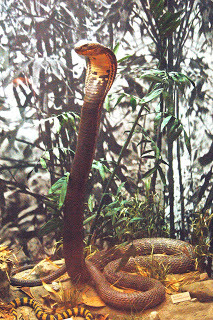 Mounted specimen of king cobra at the Royal Ontario Museum (© Hectonichus/Wikipedia)
Mounted specimen of king cobra at the Royal Ontario Museum (© Hectonichus/Wikipedia)Suddenly, however, the snake-priestess's performance reached its particular climax in a manner never mirrored by that of any matador. With her hands placed behind her back, she moved a little closer to her lethal god, and during a moment when it remained erect but immobile she leaned forward and lightly kissed the king cobra on top of its head! Drawing back instantaneously, she countered the inevitable strike that ensued, after which she promptly kissed the cobra again, and, after deflecting its consequent lunge, kissed it a third time too. The ceremony thus concluded, she simply turned her back on the cobra, and walked away, slowly but apparently untroubled, towards Denis and the waiting villagers. Nor was her confidence betrayed by the cobra - instead of striking her from behind, it merely turned aside and slid swiftly from sight into its cave.
If, during the journey back to the village, Denis had suspected that he had been hallucinating, and that this astonishing ritual had never happened, one could surely have forgiven him, for it certainly seems almost beyond belief that such a performance could ever take place. However, he had conclusive evidence for its reality right before his eyes. Clearly visible on the woman's white skirt were many damp, amber-hued stains - the potent venom of a king cobra, the legacy of her audience with her ophidian deity.
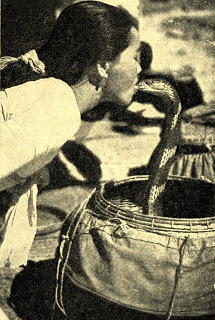 A Burmese snake-priestess kissing a king cobra on its mouth! (public domain)
A Burmese snake-priestess kissing a king cobra on its mouth! (public domain)This astonishing performance has been witnessed over the years by other Western observers too. Moreover, Dr Desmond Morris’s book Men and Snakes (1965) reports an even more incredible variation on its macabre theme – in which the snake-goddess kisses the king cobra not on top of its head but directly on its mouth! This terrifying deed was also regularly performed by top Burmese snake charmer Saya Hnin-Mahla as the climax of her act with her co-performer, an adult king cobra (see photograph opening this present ShukerNature blog article).
SPITTING IN THE FACE OF DANGER – LITERALLY!Narrating a selection of his varied wildlife experiences on an LP record (again entitled On Safari), Armand Denis recalled a second, no less extraordinary encounter that he had witnessed between king cobra and human. Just before World War II, Denis was in Singapore on a filming assignment, and in order to complete the wildlife film that he had been working upon he advertised locally for a number of king cobras, a common species in that area. Eventually, he received about a dozen, all adult and extremely belligerent, which he maintained in a securely-fastened crate with a fine wire-netting top, whose mesh they profusely drenched with their potent venom as they struck at it repeatedly in their fury at finding themselves held captive in this manner.
 On Safari
LP (© Armand and Michaela Denis/Pye Records)
On Safari
LP (© Armand and Michaela Denis/Pye Records)One day, a young Chinese boy, dressed in a strange white garb with deep sleeves, arrived at Denis's hotel, and gravely volunteered his services to Denis as a snake-handler, provided that Denis would give him one of the king cobras at the end of the filming sessions. Although he naturally doubted the boy's capability to handle such dangerous snakes as these in safety, Denis was sufficiently intrigued by his serious demeanour and outlandish offer to allow him to take a look at the cobras, while they writhed irritably but impotently within the confines of their locked crate. The boy soon focused his attention upon one especially large and aggressive specimen, which he considered to be very beautiful, and which, he assured Denis, he would have no problem in handling. Needless to say, Denis swiftly reminded him that this was a lethal creature that no-one would dare to handle in its current, highly emotional state; not until it had quietened down during several days of captivity could it be considered in any way safe to deal with, and only then for filming purposes.
 A captive adult king cobra (© Enygmatic-Halcyon/Wikipedia)
A captive adult king cobra (© Enygmatic-Halcyon/Wikipedia)The boy merely smiled, however, and asserted confidently that it would be very easy for him to handle it now - straight away - and in complete safety. He then began to prise up one corner of the crate, and Denis, very much alarmed, implored him to leave the snake alone. In response, the boy paused, and withdrew from the folds of one of his long sleeves a small vial of strange green liquid, which, when uncorked, released a fragrance vaguely reminiscent of freshly-cut grass. He poured some of this into his mouth, and then leaned down to the crate, until his face was well within the cobra's striking range. Hardly daring to look, Denis could only stand and await the inevitable, instantaneous strike that would swiftly bring death to this foolish child. Instead, it was the boy who acted first, and in a very unexpected manner.
Leaning even closer to the crate, he suddenly spat the liquid out of his mouth, spraying it liberally all over the face, head, and body of his chosen cobra! The boy waited for about a minute, and then - to Denis's even greater surprise, and absolute horror! - he casually reached into the crate and lifted the cobra out, his hands around the middle of its body's great length, holding this huge deadly serpent with no more concern than any other child might display when holding a length of cord or a skipping rope. By some uncanny means, the green liquid appeared to have rendered the cobra almost totally passive; true, it reared its ebony-scaled, fist-sized head upwards to gaze evenly at its young captor, but it made no attempt to strike at him.
After a time, the boy placed the cobra back into the crate, bowed solemnly to a still-stupefied Denis, and walked out of his room, promising to come back the following morning, and handle all of the cobras in the crate - but he did not return, and Denis never saw his mysterious visitor again.
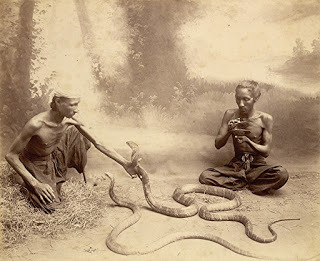 Vintage photograph of snake charmers with adult king cobras (public domain)
Vintage photograph of snake charmers with adult king cobras (public domain)When asked during an interview with a British newspaper some years ago to disclose the secret of successful snake training, Yogi Raj Bengali, one of the world's most celebrated snake-charmers, merely smiled, and stated that although some do become accustomed to a certain touch and are quite placid, for the most part snakes cannot be trained; they simply do whatever they want to do.
Bearing in mind that these are the words of an expert in the handling of potentially lethal snakes, it seems safe to assume that the mystical links between king cobras and their contemporary human courtiers have far from vanished, and that there is much still to be comprehended in this most perilous but potent of partnerships.
This ShukerNature blog article is excerpted and expanded from my book Extraordinary Animals Revisited: From Singing Dogs to Serpent Kings .

Published on July 09, 2015 08:14
Karl Shuker's Blog
- Karl Shuker's profile
- 45 followers
Karl Shuker isn't a Goodreads Author
(yet),
but they
do have a blog,
so here are some recent posts imported from
their feed.



